Paul van Yperen's Blog, page 371
September 6, 2015
Miguel Bosé
Handsome Spanish singer and actor Miguel Bosé (1956) was a major teen idol in Southern Europe between 1977 and 1982. Later he became popular as a pop singer in Latin America. As an actor he worked with interesting directors like Dario Argento, Pedro Almodóvar and Patrice Chereau.
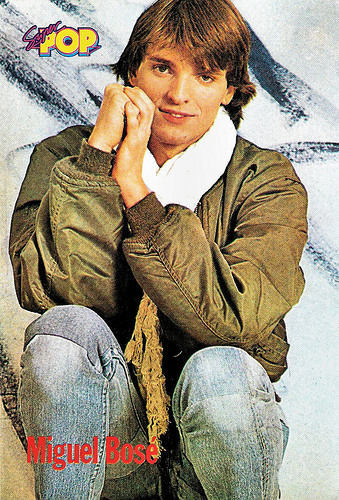
Spanish postcard in the series Tus Idolos by Super Pop Tu revista.
Suspiria
Miguel Bosé was born Miguel Luchino González Borlani in 1956 in San Fernando Hospital in Panama City, Panama. He was the son of Italian actress Lucia Bosè and bullfighter Luis Miguel Dominguín. He grew up in an environment surrounded by art and culture. Close friends of his family were Pablo Picasso and Ernest Hemingway. His godfather was Luchino Visconti and Pablo Picasso was the godfather of his sister Paola Dominguin.
In 1971, propelled by his famous family and their friends, Bosé started a career as an actor. He appeared in small roles in Italian films like the war-comedy Gli eroi/The Heroes (Duccio Tessari, 1973) and the exploitation crime film La Orca/Snatch (Eriprando Visconti, 1976) with Michele Placido.
Bosé quickly won spots on the basis of his talent and good looks alone, rather than his name, and he did study serious acting as well as dancing and singing. In 1975 he started exploring his talents as a singer. With the assistance of Camilo Blanes he recorded his first singles.
Two years later, in 1977, Bosé signed a contract with CBS Records, and he remained with them until 1984. Between 1977 and 1982, Bosè was a major teen idol in Italy (where he sang in Italian and English) and in Spain (where he sang in Spanish). He had 7 top ten hits in a disco/new wave trend that earned him a secure spot in every televised song festival held in Southern Europe.
During this period, he continued to play in films, including the Spanish production Retrato de Familia/Family Portrait (Antonio Giménez-Rico, 1976), the Spaghetti Western California (Michele Lupo, 1977) starring Giulianno Gemma, and the classic Giallo Suspiria/Sighs (Dario Argento, 1977) with Jessica Harper.
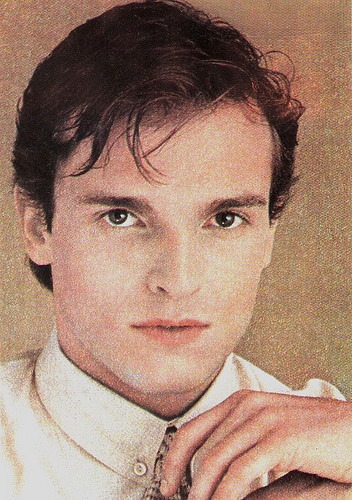
Romanian postcard by Casa Filmului Acin.
High Heels
In 1983, Miguel Bosé’s star had severely waned in Italy, and he rarely performed there again until the 2000s. In 1983, 1984, and 1985, Bosé participated in the Llena Tu Cabeza De Rock television specials on Puerto Rico WAPA-TV. In 1985 his song Amante bandido rose to the top of the charts all over Latin America and in Spain. The video to that song also became one of the most widely seen Spanish music videos, with Bose playing both a Superman style superhero and an Indiana Jones type of adventurer in it.
He revived his international film career with roles in the Italian comedy L'avaro/The Miser (Tonino Cervi, 1990), starring Alberto Sordi and Laura Antonelli , and the Spanish melodrama Tacones lejanos/High Heels (Pedro Almodóvar, 1991) starring Marisa Paredes and Victoria Abril.
In Tacones lejanos, the male lead was difficult to cast. The actor had to be believable in drag and as a judge. When the role eventually went to Bosé, his casting was a cause célèbre of the film publicity. The film was enormously successful in Spain and eventually it came second in terms of box-office takings to Mujeres al borde de un ataque de nervios/Women on the Verge of a Nervous Breakdown (1988) among Almodóvar's films released up to that point. High Heels was also a success in France and Italy, but did less well in other countries.
Bosé then played the lead in the French drama Mazeppa (Bartabas, 1993) and the excellent French period film La Reine Margot/Queen Margot (Patrice Chéreau, 1994) featuring Isabelle Adjani and Vincent Perez. His later films were less successful.
Musically, he would return to the top in Italy in 1994, by winning the musical event Festivalbar for the third time. In the following decade, Bosé's popularity continued undiminished as he released four more studio albums and two live albums. In 2007, to celebrate his 30 years as a singer, he released Papito, an album that contains remakes of his previous songs, re-interpreted in duets with artists like Juanes, Alejandro Sanz, Laura Pausini, Shakira, Ricky Martin, and Michael Stipe from R.E.M..
His hit single Nena, featuring Mexican superstar Paulina Rubio, was nominated for a Latin Grammy for best song, and became the best selling download of Spain in 2007. In 2008, Colombian President Álvaro Uribe offered him Colombian citizenship because of his efforts towards peace in Colombia, including his participation in two concerts in 2008. In 2010 he received Colombian citizenship. In 2012 he released the album Papitwo, a follow-up to his successful Papito.
Zac Johnson at AllMusic : "Defying the contemporary formula for pop success, his music has been described as a global fusion of many musical influences. At the center of his music is all the passion and expression of a Latin artist, yet Miguel Bosé has constantly incorporated more diverse musical elements than many of the genre's crossover pop stars."
American trailer for Suspiria/Sighs (Dario Argento, 1977) - without Bosé. Source: EazyWWEfan's channel (YouTube).
Trailer for the Spaghetti Western California (Michele Lupo, 1977). Source: The Spaghetti Western Database (YouTube).
Trailer for Tacones lejanos/High Heels (Pedro Almodóvar, 1991). Source: Eldeseopc (YouTube).
Video clip for the song Nena (2007). Source: Miguel Bosé (YouTube).
Video clip for the song Encanto of Miguel Bosé's laste album Amo (2014). Source: Miguel Bosé (YouTube).
Sources: Zac Johnson (AllMusic), Wikipedia and .

Spanish postcard in the series Tus Idolos by Super Pop Tu revista.
Suspiria
Miguel Bosé was born Miguel Luchino González Borlani in 1956 in San Fernando Hospital in Panama City, Panama. He was the son of Italian actress Lucia Bosè and bullfighter Luis Miguel Dominguín. He grew up in an environment surrounded by art and culture. Close friends of his family were Pablo Picasso and Ernest Hemingway. His godfather was Luchino Visconti and Pablo Picasso was the godfather of his sister Paola Dominguin.
In 1971, propelled by his famous family and their friends, Bosé started a career as an actor. He appeared in small roles in Italian films like the war-comedy Gli eroi/The Heroes (Duccio Tessari, 1973) and the exploitation crime film La Orca/Snatch (Eriprando Visconti, 1976) with Michele Placido.
Bosé quickly won spots on the basis of his talent and good looks alone, rather than his name, and he did study serious acting as well as dancing and singing. In 1975 he started exploring his talents as a singer. With the assistance of Camilo Blanes he recorded his first singles.
Two years later, in 1977, Bosé signed a contract with CBS Records, and he remained with them until 1984. Between 1977 and 1982, Bosè was a major teen idol in Italy (where he sang in Italian and English) and in Spain (where he sang in Spanish). He had 7 top ten hits in a disco/new wave trend that earned him a secure spot in every televised song festival held in Southern Europe.
During this period, he continued to play in films, including the Spanish production Retrato de Familia/Family Portrait (Antonio Giménez-Rico, 1976), the Spaghetti Western California (Michele Lupo, 1977) starring Giulianno Gemma, and the classic Giallo Suspiria/Sighs (Dario Argento, 1977) with Jessica Harper.

Romanian postcard by Casa Filmului Acin.
High Heels
In 1983, Miguel Bosé’s star had severely waned in Italy, and he rarely performed there again until the 2000s. In 1983, 1984, and 1985, Bosé participated in the Llena Tu Cabeza De Rock television specials on Puerto Rico WAPA-TV. In 1985 his song Amante bandido rose to the top of the charts all over Latin America and in Spain. The video to that song also became one of the most widely seen Spanish music videos, with Bose playing both a Superman style superhero and an Indiana Jones type of adventurer in it.
He revived his international film career with roles in the Italian comedy L'avaro/The Miser (Tonino Cervi, 1990), starring Alberto Sordi and Laura Antonelli , and the Spanish melodrama Tacones lejanos/High Heels (Pedro Almodóvar, 1991) starring Marisa Paredes and Victoria Abril.
In Tacones lejanos, the male lead was difficult to cast. The actor had to be believable in drag and as a judge. When the role eventually went to Bosé, his casting was a cause célèbre of the film publicity. The film was enormously successful in Spain and eventually it came second in terms of box-office takings to Mujeres al borde de un ataque de nervios/Women on the Verge of a Nervous Breakdown (1988) among Almodóvar's films released up to that point. High Heels was also a success in France and Italy, but did less well in other countries.
Bosé then played the lead in the French drama Mazeppa (Bartabas, 1993) and the excellent French period film La Reine Margot/Queen Margot (Patrice Chéreau, 1994) featuring Isabelle Adjani and Vincent Perez. His later films were less successful.
Musically, he would return to the top in Italy in 1994, by winning the musical event Festivalbar for the third time. In the following decade, Bosé's popularity continued undiminished as he released four more studio albums and two live albums. In 2007, to celebrate his 30 years as a singer, he released Papito, an album that contains remakes of his previous songs, re-interpreted in duets with artists like Juanes, Alejandro Sanz, Laura Pausini, Shakira, Ricky Martin, and Michael Stipe from R.E.M..
His hit single Nena, featuring Mexican superstar Paulina Rubio, was nominated for a Latin Grammy for best song, and became the best selling download of Spain in 2007. In 2008, Colombian President Álvaro Uribe offered him Colombian citizenship because of his efforts towards peace in Colombia, including his participation in two concerts in 2008. In 2010 he received Colombian citizenship. In 2012 he released the album Papitwo, a follow-up to his successful Papito.
Zac Johnson at AllMusic : "Defying the contemporary formula for pop success, his music has been described as a global fusion of many musical influences. At the center of his music is all the passion and expression of a Latin artist, yet Miguel Bosé has constantly incorporated more diverse musical elements than many of the genre's crossover pop stars."
American trailer for Suspiria/Sighs (Dario Argento, 1977) - without Bosé. Source: EazyWWEfan's channel (YouTube).
Trailer for the Spaghetti Western California (Michele Lupo, 1977). Source: The Spaghetti Western Database (YouTube).
Trailer for Tacones lejanos/High Heels (Pedro Almodóvar, 1991). Source: Eldeseopc (YouTube).
Video clip for the song Nena (2007). Source: Miguel Bosé (YouTube).
Video clip for the song Encanto of Miguel Bosé's laste album Amo (2014). Source: Miguel Bosé (YouTube).
Sources: Zac Johnson (AllMusic), Wikipedia and .
Published on September 06, 2015 22:00
September 5, 2015
Charles Vanel
French actor and director Charles Vanel (1892-1989) was a craggy-faced character actor with a rumbling voice and a piercing gaze. In a cinema career of 77 years, this ‘monument of the French cinema’ played in over 200 silent and sound films, in France and abroad. Vanel is best remembered as the silent driver in Le salaire de la peur/The Wages of Fear (Henri-Georges Clouzot, 1953), the retired chief commissioner in Les diaboliques/Diabolique (Henri-Georges Clouzot, 1955), and the policeman in To Catch a Thief (Alfred Hitchcock, 1955).
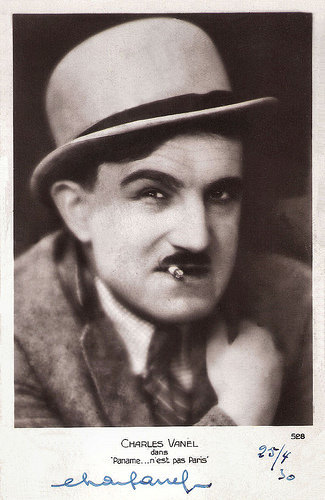
French postcard by Cinemagazine Edition, Paris, no. 528. Photo: publicity still for Paname... nést pas Paris/Apaches of Paris (Nikolai Malikoff, 1927). Signed by Vanel at 25 April 1930.
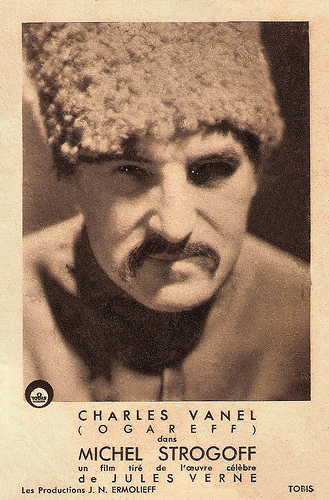
French postcard. Photo: Tobis / Les Productions J.N. Ermolieff. Publicity still of Charles Vanel as Ogareff in Michel Strogoff (Jacques de Baroncelli, 1936).
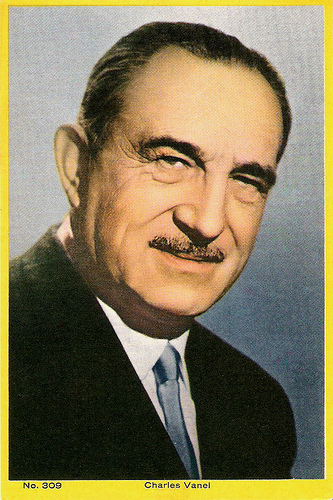
Mexican card.
A Prolific Silent Film Career
Charles-Marie Vanel was born in Rennes, France, in 1892. His family moved to Paris in 1904, where his parents became shopkeepers. His adolescence was not very happy, being expelled by all the schools which he frequented. He tried to enlist in the Navy, but his poor sight put an end to this ambition.
Possessing a very fine voice, he decided to become an actor and in 1908, he made his stage debut in Hamlet at the age of 16. In 1912 followed his first film appearance in the short Western Jim Crow (Robert Péguy, 1912) opposite Joë Hamman . He participated in numerous theatre tours, in particular with Lucien Guitry during the war. Then he worked with Firmin Gémier at the Theatre Antoine before dedicating himself exclusively to the cinema.
His films of the 1910s included La p'tite du sixième/The Little Girl of the 6th (Louis Mercanton, René Hervil, 1917) and Miarka, la fille à l'ourse/Gypsy Passion (Louis Mercanton, 1920) with Réjane. He acted with the legendary Russian actor Ivan Mozzhukhin in L'Enfant du carnaval/The Child of the Carnival (Ivan Mozzhukhin, 1921), Tempêtes/Tempests (Robert Boudrioz, 1922), and La Maison du mystère/The House of Mystery (Alexandre Volkoff, 1923).
Vanel had his first success in Robert Boudrioz's drama about the grim life of French peasants, L'Atre/Tillers of the Soil (1922). This marked the beginning of a prolific silent film career. He appeared in many films by Jacques de Baroncelli, particularly in the Pierre Loti story Pêcheur d'Islande/Island Fishermen (1927), filmed in his native Brittany. He played in Germaine Dulac's melodrama Ame d'artiste/Heart of an Actress (1924) and René Clair's comedy drama Proie du vent/Prey of the Wind (1927) with Sandra Milowanoff . Vanel worked for German and Italian directors, and played Napoleon in Karl Grüne's Waterloo (1929).
Vanel directed Sandra Milowanoff in the feature film Dans la Nuit/In the Night (1929), in which he also played the leading role. This silent film was overlooked at the time because of the coming of sound, and it would stay the only feature film directed by Vanel. In 2002, at the request of filmmaker Bertrand Tavernier, Louis Sclavis composed and recorded a soundtrack for the film, and the Cinématheque Française restored Dans la Nuit. At Film Reference , Liam O’Leary writes: “which allows us to see a very talented director indeed. This story of rural love and jealousy set among quarry workers has a documentary realism”.
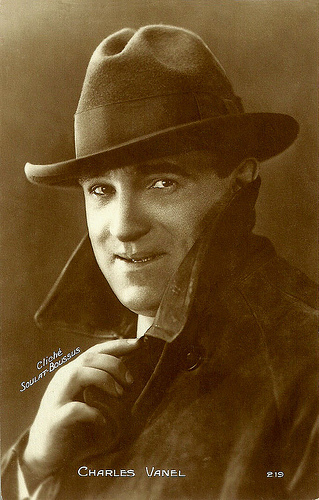
French postcard by Cinémagazine, no. 219 Photo: Soulat-Boussus.
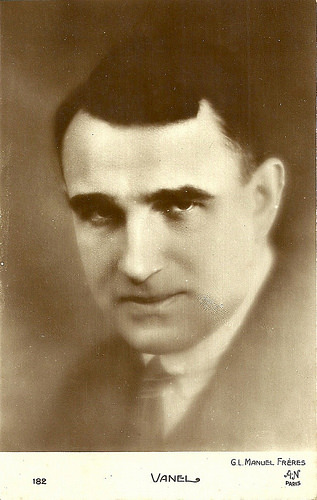
French postcard by A.N., Paris, no. 182. Photo: G.L. Manuel Frères.
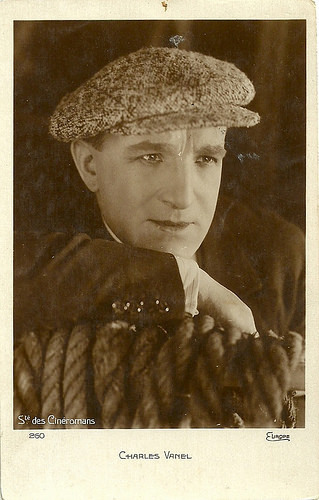
French postcard by Europe, no. 260. Photo: Société des Cinéromans.
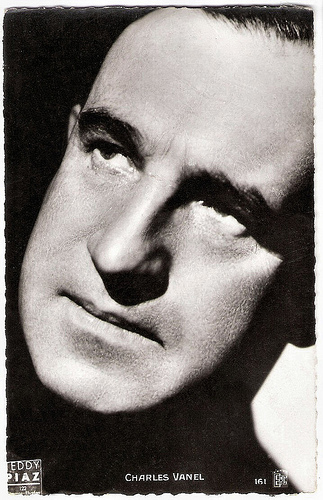
French postcard by Editions et Publications cinématographiques (EPC), no. 161. Photo: Teddy Piaz.
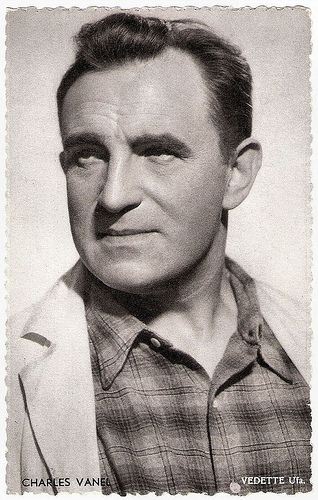
Belgian postcard by N. Els, Bromurite. Offered by Kwatta. Photo: Ufa.
Clouzot's Stock Company
With the arrival of sound, Charles Vanel spent two years in Germany on French versions of German films. On his return to France he became a familiar figure on the cinema screen. He played the nasty, relentless Inspector Javert opposite Harry Baur in the two-part screen version of Les Misérables (Raymond Bernard, 1934) and also appeared in Bernard’s prostitution and drugs drama Faubourg Montmarte (Raymond Bernard, 1931) and the powerful anti-war film Les Croix de bois/Wooden Crosses (Raymond Bernard, 1932).
He was in the Foreign Legion melodrama Le Grand Jeu/The Full Deck (Jacques Feyder, 1934), he played Jean Gabin ’s buddy in the smash hit La Belle Equipe/The Good Crew (Julien Duvivier, 1936), and he appeared in Marcel Carné's first film as director, Jenny (1936), featuring Françoise Rosay. He also starred in Feyder’s La Loi du nord/Law of the North (Jacques Feyder, 1939) with Michèle Morgan .
His popularity diminished during the war years, but he was able to stage a comeback as a member of director Henri-Georges Clouzot's stock company. He played his most famous role as the eldest of four men assigned to drive two truckloads of nitroglycerine across dangerous terrain in Clouzot's agonisingly suspenseful Le Salaire de la peur/The Wages of Fear (Henri-Georges Clouzot, 1953). His increasingly frail character suffers humiliation at the hands of Yves Montand and endures remarkable physical torment during the dangers of the journey. For this role he received the Best Actor award at the Cannes Film Festival.
He reunited with Clouzot for Les Diaboliques/Diabolique (Henri-Georges Clouzot, 1955), and the courtroom drama La verité/The Truth (Henri-Georges Clouzot, 1958) starring Brigitte Bardot . At AllMovie , Jason Ankeny calls Les Diaboliques ‘The greatest film that Alfred Hitchcock never made: “A dark, dank thriller with a much-imitated ‘shock’ ending, Diabolique is a masterpiece of Grand Guignol suspense. The simple murder plot goes haywire, and Michel's corpse disappears, prompting strange rumors of his reappearance which grow more and more substantial as the film careens wildly towards its breathless conclusion.”
That same year Alfred Hitchcock cast Vanel as a policeman on the trail of cat burglar Cary Grant in To Catch a Thief (Alfred Hitchcock, 1955). It would be Vanel’s only Hollywood production. The following years he worked for other famous directors like Luis Buñuel in Le Mort en ce jardin/Death in the Garden (1956), Alberto Lattuada in La Steppa/The Steppe (1962), and Jean Pierre Melville in L'Ainé des Ferchaux/An Honorable Young Man (1962).
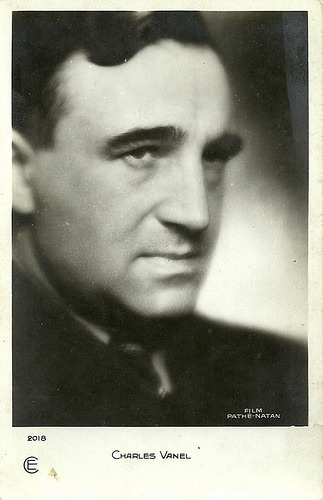
French postcard by CE, no. 2018. Photo: Film Pathé-Natan.
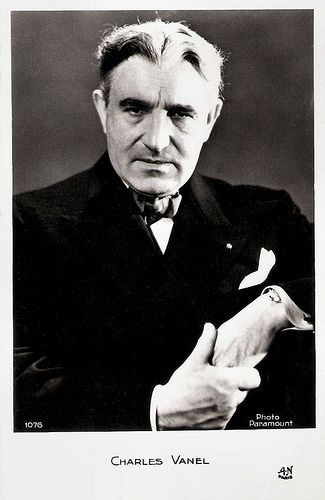
French postcard by A.N., Paris, no. 1076. Photo: Paramount.
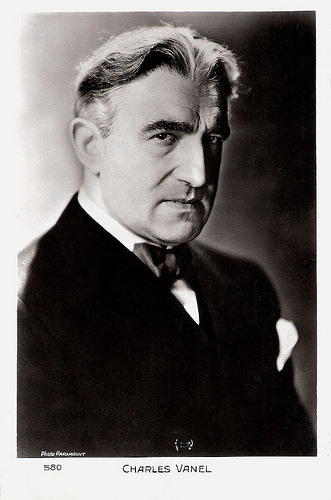
French postcard by Editions Chantal, Paris, no. 580. Photo: Paramount.
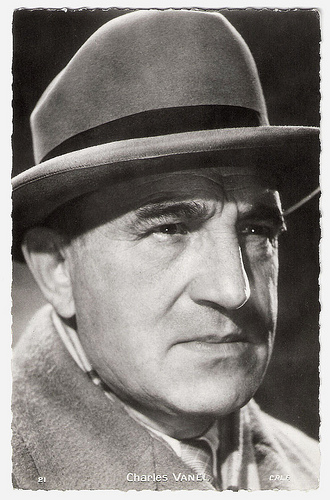
French postcard by Editions E.C., Paris, no. 21. Photo: C.P.L.E.
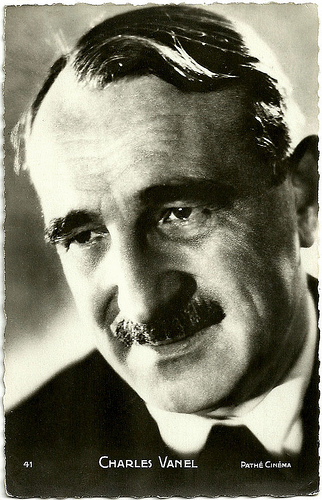
French postcard by Editions P.I., Paris, no. 41. Photo: Pathé Cinéma.
Sobriety and the Correct Tone
Charles Vanel was increasingly active on TV in the 1960s and 1970s, although he continued to appear in interesting films like the thriller Un homme de trop/Shock Troops (Costa Gravas, 1967).
At his site, author Jean Bernard-Luc analyses Vanel’s style: “Sobriety and the correct tone characterize Vanel’s acting. His monolithic appearance, his impassiveness is denied by his eyes, in which concentrates the intense life of his character. Most times, he played the dutiful man, whether he is a state employee, a serviceman, an adventurer or a gangster. He was almost never a seducer.”
In real life Vanel was married to Arlette Mauricette Bailly, and they lived in the south of France for the last 20 years of his life. As late as 1976 he played the leading role of the grandfather in the docudrama Es Herrscht Ruhe im Land/The Country Is Calm (Peter Lilienthal, 1976). That year he also appeared in the psychological drama Alice ou la Derniere Fugue/Alice or the Last Escapade (Claude Chabrol, 1976) starring Sylvia Kristel .
He played memorable parts in the Italian films Cadaveri eccellenti/The Excellent Corpses (Francesco Rosi, 1976) and Tre fratelli/Three Brothers (Francesco Rosi, 1981), an adaptation of a work by Andrei Platonov. The latter earned a Best Foreign Film Oscar nomination.
On 1978 Vanel was honoured with a special César award. He retired in 1982, only to make a wholly unexpected comeback at the age of 95 as an old prophet in Si le Soleil Ne Revenait Pas/If The Sun Never Returns (Claude Goretta, 1987). In Les Saisons Du Plaisir/The Seasons of Pleasure (Jean-Pierre Mocky, 1988) he played a 100-year-old perfume magnate who decides to marry. This would be his last film.
Charles Vanel died in 1989, in Cannes, France, at the age of 96. He had the longest career of any French film actor. However in Germany, actor Curt Bois even had an 80-year film career. In an interview with a Swiss newspaper in 1986, Vanel said: "You know, in our profession, there is no end. As long as one has the strength to do it, you can act."
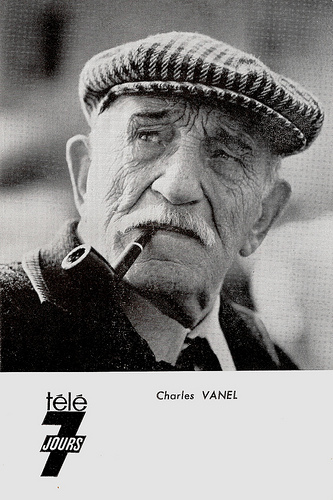
French postcard by Télé 7 Jours.
Scene from La Belle Equipe/The Good Crew (1936). Source: Herrmith (YouTube). Sorry, no subtitles.
Trailer for Le salaire de la peur/The wages of fear (1953). Source: Fransefilms (YouTube).
Trailer for To catch a Thief (1955). Source: Video Detective (YouTube).
Trailer Cadaveri eccellenti/The Excellent Corpses (1976). Source: Mr Onlineclip (YouTube).
Sources: Liam O'Leary (Film Reference), Hal Erickson (AllMovie), Jason Ankeny (AllMovie), Jean Bernard-Luc (French), New York Times, TCM, Wikipedia and .

French postcard by Cinemagazine Edition, Paris, no. 528. Photo: publicity still for Paname... nést pas Paris/Apaches of Paris (Nikolai Malikoff, 1927). Signed by Vanel at 25 April 1930.

French postcard. Photo: Tobis / Les Productions J.N. Ermolieff. Publicity still of Charles Vanel as Ogareff in Michel Strogoff (Jacques de Baroncelli, 1936).

Mexican card.
A Prolific Silent Film Career
Charles-Marie Vanel was born in Rennes, France, in 1892. His family moved to Paris in 1904, where his parents became shopkeepers. His adolescence was not very happy, being expelled by all the schools which he frequented. He tried to enlist in the Navy, but his poor sight put an end to this ambition.
Possessing a very fine voice, he decided to become an actor and in 1908, he made his stage debut in Hamlet at the age of 16. In 1912 followed his first film appearance in the short Western Jim Crow (Robert Péguy, 1912) opposite Joë Hamman . He participated in numerous theatre tours, in particular with Lucien Guitry during the war. Then he worked with Firmin Gémier at the Theatre Antoine before dedicating himself exclusively to the cinema.
His films of the 1910s included La p'tite du sixième/The Little Girl of the 6th (Louis Mercanton, René Hervil, 1917) and Miarka, la fille à l'ourse/Gypsy Passion (Louis Mercanton, 1920) with Réjane. He acted with the legendary Russian actor Ivan Mozzhukhin in L'Enfant du carnaval/The Child of the Carnival (Ivan Mozzhukhin, 1921), Tempêtes/Tempests (Robert Boudrioz, 1922), and La Maison du mystère/The House of Mystery (Alexandre Volkoff, 1923).
Vanel had his first success in Robert Boudrioz's drama about the grim life of French peasants, L'Atre/Tillers of the Soil (1922). This marked the beginning of a prolific silent film career. He appeared in many films by Jacques de Baroncelli, particularly in the Pierre Loti story Pêcheur d'Islande/Island Fishermen (1927), filmed in his native Brittany. He played in Germaine Dulac's melodrama Ame d'artiste/Heart of an Actress (1924) and René Clair's comedy drama Proie du vent/Prey of the Wind (1927) with Sandra Milowanoff . Vanel worked for German and Italian directors, and played Napoleon in Karl Grüne's Waterloo (1929).
Vanel directed Sandra Milowanoff in the feature film Dans la Nuit/In the Night (1929), in which he also played the leading role. This silent film was overlooked at the time because of the coming of sound, and it would stay the only feature film directed by Vanel. In 2002, at the request of filmmaker Bertrand Tavernier, Louis Sclavis composed and recorded a soundtrack for the film, and the Cinématheque Française restored Dans la Nuit. At Film Reference , Liam O’Leary writes: “which allows us to see a very talented director indeed. This story of rural love and jealousy set among quarry workers has a documentary realism”.

French postcard by Cinémagazine, no. 219 Photo: Soulat-Boussus.

French postcard by A.N., Paris, no. 182. Photo: G.L. Manuel Frères.

French postcard by Europe, no. 260. Photo: Société des Cinéromans.

French postcard by Editions et Publications cinématographiques (EPC), no. 161. Photo: Teddy Piaz.

Belgian postcard by N. Els, Bromurite. Offered by Kwatta. Photo: Ufa.
Clouzot's Stock Company
With the arrival of sound, Charles Vanel spent two years in Germany on French versions of German films. On his return to France he became a familiar figure on the cinema screen. He played the nasty, relentless Inspector Javert opposite Harry Baur in the two-part screen version of Les Misérables (Raymond Bernard, 1934) and also appeared in Bernard’s prostitution and drugs drama Faubourg Montmarte (Raymond Bernard, 1931) and the powerful anti-war film Les Croix de bois/Wooden Crosses (Raymond Bernard, 1932).
He was in the Foreign Legion melodrama Le Grand Jeu/The Full Deck (Jacques Feyder, 1934), he played Jean Gabin ’s buddy in the smash hit La Belle Equipe/The Good Crew (Julien Duvivier, 1936), and he appeared in Marcel Carné's first film as director, Jenny (1936), featuring Françoise Rosay. He also starred in Feyder’s La Loi du nord/Law of the North (Jacques Feyder, 1939) with Michèle Morgan .
His popularity diminished during the war years, but he was able to stage a comeback as a member of director Henri-Georges Clouzot's stock company. He played his most famous role as the eldest of four men assigned to drive two truckloads of nitroglycerine across dangerous terrain in Clouzot's agonisingly suspenseful Le Salaire de la peur/The Wages of Fear (Henri-Georges Clouzot, 1953). His increasingly frail character suffers humiliation at the hands of Yves Montand and endures remarkable physical torment during the dangers of the journey. For this role he received the Best Actor award at the Cannes Film Festival.
He reunited with Clouzot for Les Diaboliques/Diabolique (Henri-Georges Clouzot, 1955), and the courtroom drama La verité/The Truth (Henri-Georges Clouzot, 1958) starring Brigitte Bardot . At AllMovie , Jason Ankeny calls Les Diaboliques ‘The greatest film that Alfred Hitchcock never made: “A dark, dank thriller with a much-imitated ‘shock’ ending, Diabolique is a masterpiece of Grand Guignol suspense. The simple murder plot goes haywire, and Michel's corpse disappears, prompting strange rumors of his reappearance which grow more and more substantial as the film careens wildly towards its breathless conclusion.”
That same year Alfred Hitchcock cast Vanel as a policeman on the trail of cat burglar Cary Grant in To Catch a Thief (Alfred Hitchcock, 1955). It would be Vanel’s only Hollywood production. The following years he worked for other famous directors like Luis Buñuel in Le Mort en ce jardin/Death in the Garden (1956), Alberto Lattuada in La Steppa/The Steppe (1962), and Jean Pierre Melville in L'Ainé des Ferchaux/An Honorable Young Man (1962).

French postcard by CE, no. 2018. Photo: Film Pathé-Natan.

French postcard by A.N., Paris, no. 1076. Photo: Paramount.

French postcard by Editions Chantal, Paris, no. 580. Photo: Paramount.

French postcard by Editions E.C., Paris, no. 21. Photo: C.P.L.E.

French postcard by Editions P.I., Paris, no. 41. Photo: Pathé Cinéma.
Sobriety and the Correct Tone
Charles Vanel was increasingly active on TV in the 1960s and 1970s, although he continued to appear in interesting films like the thriller Un homme de trop/Shock Troops (Costa Gravas, 1967).
At his site, author Jean Bernard-Luc analyses Vanel’s style: “Sobriety and the correct tone characterize Vanel’s acting. His monolithic appearance, his impassiveness is denied by his eyes, in which concentrates the intense life of his character. Most times, he played the dutiful man, whether he is a state employee, a serviceman, an adventurer or a gangster. He was almost never a seducer.”
In real life Vanel was married to Arlette Mauricette Bailly, and they lived in the south of France for the last 20 years of his life. As late as 1976 he played the leading role of the grandfather in the docudrama Es Herrscht Ruhe im Land/The Country Is Calm (Peter Lilienthal, 1976). That year he also appeared in the psychological drama Alice ou la Derniere Fugue/Alice or the Last Escapade (Claude Chabrol, 1976) starring Sylvia Kristel .
He played memorable parts in the Italian films Cadaveri eccellenti/The Excellent Corpses (Francesco Rosi, 1976) and Tre fratelli/Three Brothers (Francesco Rosi, 1981), an adaptation of a work by Andrei Platonov. The latter earned a Best Foreign Film Oscar nomination.
On 1978 Vanel was honoured with a special César award. He retired in 1982, only to make a wholly unexpected comeback at the age of 95 as an old prophet in Si le Soleil Ne Revenait Pas/If The Sun Never Returns (Claude Goretta, 1987). In Les Saisons Du Plaisir/The Seasons of Pleasure (Jean-Pierre Mocky, 1988) he played a 100-year-old perfume magnate who decides to marry. This would be his last film.
Charles Vanel died in 1989, in Cannes, France, at the age of 96. He had the longest career of any French film actor. However in Germany, actor Curt Bois even had an 80-year film career. In an interview with a Swiss newspaper in 1986, Vanel said: "You know, in our profession, there is no end. As long as one has the strength to do it, you can act."

French postcard by Télé 7 Jours.
Scene from La Belle Equipe/The Good Crew (1936). Source: Herrmith (YouTube). Sorry, no subtitles.
Trailer for Le salaire de la peur/The wages of fear (1953). Source: Fransefilms (YouTube).
Trailer for To catch a Thief (1955). Source: Video Detective (YouTube).
Trailer Cadaveri eccellenti/The Excellent Corpses (1976). Source: Mr Onlineclip (YouTube).
Sources: Liam O'Leary (Film Reference), Hal Erickson (AllMovie), Jason Ankeny (AllMovie), Jean Bernard-Luc (French), New York Times, TCM, Wikipedia and .
Published on September 05, 2015 22:00
September 4, 2015
Das Schicksal der Carola von Geldern (1919)
Today a post on a series of Ross Verlag postcards for the silent salon melodrama Das Schicksal der Carola von Geldern/The destiny of Carola von Geldern (Carl Froehlich, 1919). The young aristocratic Carola of the title is played by Lotte Neumann, one of the most successful actresses in the early days of the German cinema.
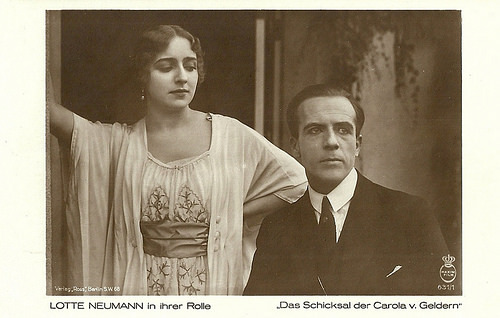
German postcard by Ross Verlag, Berlin, no. 631/1. Photo: Maxim Film. Publicity still for Das Schicksal der Carola von Geldern (Carl Froehlich, 1919).
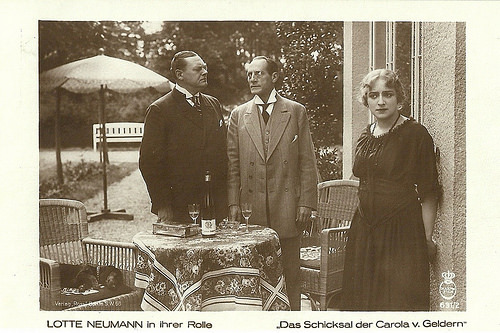
German postcard by Ross Verlag, Berlin, no. 631/2. Photo: Maxim Film. Publicity still for Das Schicksal der Carola von Geldern (Carl Froehlich, 1919).
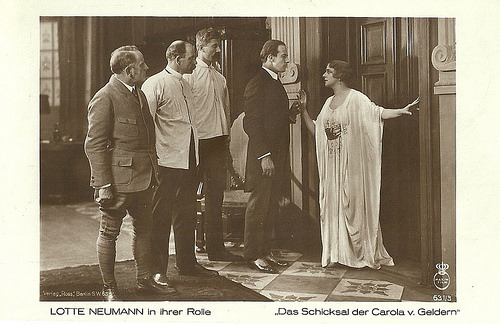
German postcard by Ross Verlag, Berlin, no. 631/3. Photo: Maxim Film. Publicity still for Das Schicksal der Carola von Geldern (Carl Froehlich, 1919).
Destiny
Das Schicksal der Carola von Geldern/The destiny of Carola von Geldern (Carl Froehlich, 1919) was adapted by Ludwig Wolff from the novel Der grosse Rachen (1915) by Olga Wohlbrück-Wendland.
The melodramatic story tells about the destiny of a mother and daughter. Carola von Geldern's mother (Grete Ebinger) has an affair with a gambler and dies. Carola ( Lotte Neumann ) herself loves a benefactor. When she has caused an accident, he kills her.
The postcards don't give a clear view of the story nor the timeline. They are focused on the star of the film, Lotte Neumann (1896-1977), who seems to play Carola in different phases of her life (in the last cards of the series, she plays a young girl with long tails). Neumann was not only a successful actress of the early German cinema, but she also worked as a screenwriter and a producer.
Who's who on the postcards is not clear to us.The other cast members were little known actors like Rudolf Lettinger (the husband, Jack von Geldern), Eduard Rothauser (Von Glienen/Von Glidien), Martin Lübbert (Dr. Graebner), Margarete Ferida (Von Glidien's girlfriend), Paul Kaufmann (Dr. Ertzky) and Mrs. Klein-Rohden (housekeeper).
Our sources differ about who is the director of the film. Possibly scriptwriter Ludwig Wolff was the (co-)director of the film, together with Carl Froelich. Cinematographer was Otto Tober, set designer Hans Sohnle.
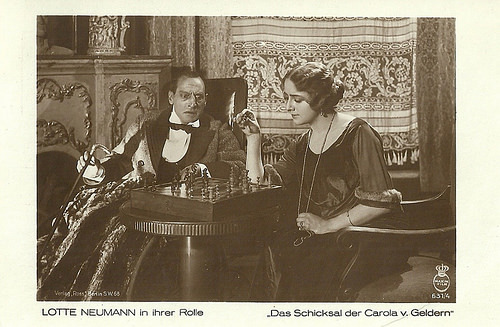
German postcard by Ross Verlag, Berlin, no. 631/4. Photo: Maxim Film. Publicity still for Das Schicksal der Carola von Geldern (Carl Froehlich, 1919).
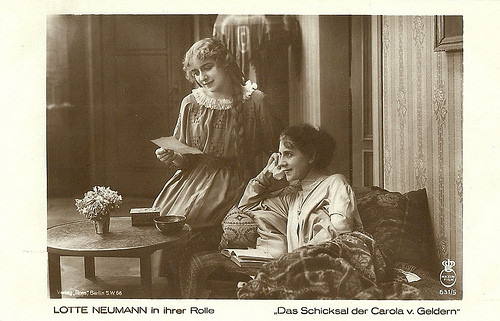
German postcard by Ross Verlag, Berlin, no. 631/5. Photo: Maxim Film. Publicity still for Das Schicksal der Carola von Geldern (Carl Froehlich, 1919).
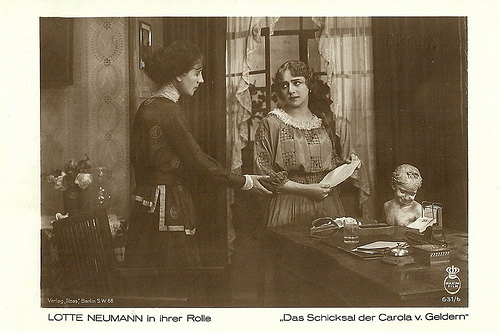
German postcard by Ross Verlag, Berlin, no. 631/6. Photo: Maxim Film. Publicity still for Das Schicksal der Carola von Geldern (Carl Froehlich, 1919).
This is a post for Postcard Friendship Friday, hosted by Beth at the blog The Best Hearts are Crunchy. You can visit her by clicking on the button below.

Sources: The German Early Cinema Database, Filmportal.de and IMDb.

German postcard by Ross Verlag, Berlin, no. 631/1. Photo: Maxim Film. Publicity still for Das Schicksal der Carola von Geldern (Carl Froehlich, 1919).

German postcard by Ross Verlag, Berlin, no. 631/2. Photo: Maxim Film. Publicity still for Das Schicksal der Carola von Geldern (Carl Froehlich, 1919).

German postcard by Ross Verlag, Berlin, no. 631/3. Photo: Maxim Film. Publicity still for Das Schicksal der Carola von Geldern (Carl Froehlich, 1919).
Destiny
Das Schicksal der Carola von Geldern/The destiny of Carola von Geldern (Carl Froehlich, 1919) was adapted by Ludwig Wolff from the novel Der grosse Rachen (1915) by Olga Wohlbrück-Wendland.
The melodramatic story tells about the destiny of a mother and daughter. Carola von Geldern's mother (Grete Ebinger) has an affair with a gambler and dies. Carola ( Lotte Neumann ) herself loves a benefactor. When she has caused an accident, he kills her.
The postcards don't give a clear view of the story nor the timeline. They are focused on the star of the film, Lotte Neumann (1896-1977), who seems to play Carola in different phases of her life (in the last cards of the series, she plays a young girl with long tails). Neumann was not only a successful actress of the early German cinema, but she also worked as a screenwriter and a producer.
Who's who on the postcards is not clear to us.The other cast members were little known actors like Rudolf Lettinger (the husband, Jack von Geldern), Eduard Rothauser (Von Glienen/Von Glidien), Martin Lübbert (Dr. Graebner), Margarete Ferida (Von Glidien's girlfriend), Paul Kaufmann (Dr. Ertzky) and Mrs. Klein-Rohden (housekeeper).
Our sources differ about who is the director of the film. Possibly scriptwriter Ludwig Wolff was the (co-)director of the film, together with Carl Froelich. Cinematographer was Otto Tober, set designer Hans Sohnle.

German postcard by Ross Verlag, Berlin, no. 631/4. Photo: Maxim Film. Publicity still for Das Schicksal der Carola von Geldern (Carl Froehlich, 1919).

German postcard by Ross Verlag, Berlin, no. 631/5. Photo: Maxim Film. Publicity still for Das Schicksal der Carola von Geldern (Carl Froehlich, 1919).

German postcard by Ross Verlag, Berlin, no. 631/6. Photo: Maxim Film. Publicity still for Das Schicksal der Carola von Geldern (Carl Froehlich, 1919).
This is a post for Postcard Friendship Friday, hosted by Beth at the blog The Best Hearts are Crunchy. You can visit her by clicking on the button below.

Sources: The German Early Cinema Database, Filmportal.de and IMDb.
Published on September 04, 2015 22:00
September 3, 2015
Rolf Hoppe
Stage and film actor Rolf Hoppe (1930) played villains in many DEFA films, produced in East-Germany.
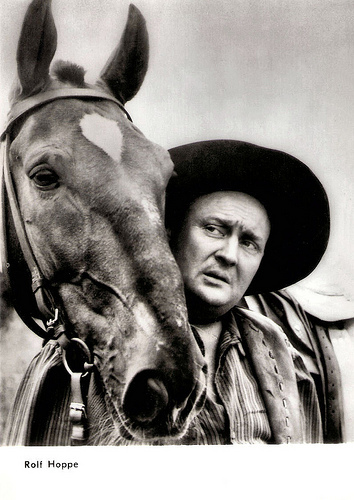
East-German postcard by VEB Progress Film-Vertrieb, Berlin, no. 221/69. Photo: publicity still for Spur des Falken/Trail of the Falcon (Gottfried Kolditz, 1968).
Easterns
Rolf Hoppe was born in 1930 as son of a master baker in Ellrich, Thuringia, Germany. After his apprenticeship as a baker, he worked from 1945 to 1948, as a coachman.
He then started an actors’ training in Erfurt and worked in the circus Aeros. He was later engaged at the Thalia Theater in Halle (Saale) and at the Young World Theatre in Leipzig. He acted at the Staatsschauspiel Dresden, the Deutsches Theater in Berlin, and the Salzburg Festival. He was internationally active in Switzerland, Italy, and China.
From 1964 on, Rolf Hoppe often appeared in films produced by the DEFA, the state-owned film studio in the German Democratic Republic (East-Germany). One of his first films was the drama Der Frühling braucht Zeit/The Spring Takes Time (Günter Stahnke, 1966), which was banned by the Communist authorities shortly after it was released.
He played villains in different ‘Osterns’ (Easterns - the typical Eastern Bloc countries' take on the Western). An example is Spur des Falken/Trail of the Falcon (Gottfried Kolditz, 1968), starring Gojko Mitic as the Indian hero. He also appeared in other Mitic films, Weiße Wölfe/White Wolves (Konrad Petzold, Bosko Boskovic, 1969), one of the most popular DEFA films ever, and Tödlicher Irrtum/Fatal error (Konrad Petzold, 1970), also with Armin Müller-Stahl .
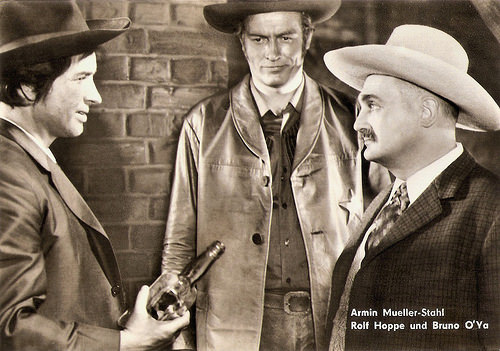
East-German postcard by VEB Progress Film-Vertrieb, Berlin, no. 65/70. Photo: DEFA / Blümel. Publicity still for Tödlicher Irrtum/Fatal Error (Konrad Petzold, 1970) with Armin Mueller-Stahl and Bruno O'Ya.
Mephisto
In 1971, Rolf Hoppe was awarded the National Prize of East Germany for artistic achievement. The following year, he appeared in the East-German Science Fiction film Eolomea (Herrmann Zschoche 1972) with Cox Habbema .
One of his most notable roles was that of the Tábornagy (Hermann Göring) in Mephisto (István Szabó, 1981), a film adaptation of Klaus Mann's novel Mephisto, starring Klaus Maria Brandauer as Hendrik Höfgen. The film was awarded the 1981 Academy Award for Best Foreign Language Film.
His later films include the crime film Ärztinnen/Woman Doctors (Horst Seemann, 1984), the drama Das Haus am Fluß/The House at the River (Roland Gräf, 1986) and the East German–Swiss drama Pestalozzis Berg/Pestalozzi's Mountain (Peter von Gunten, 1989) featuring Gian Maria Volonté. All three films were entered into editions of the Berlin International Film Festival.
Hoppe had a supporting part in the satire Schtonk! (Helmut Dietl, 1992), a retelling of the hoax of the Hitler Diaries, starring Götz George . He also had a part in another German success of the 1990s, Comedian Harmonists/The Harmonists (Joseph Vilsmaier, 1997), about the popular German vocal group the Comedian Harmonists of the 1920s and 1930s.
He then appeared in the Neo-Noir Palmetto (Volker Schlöndorff, 1998), based on the novel Just Another Sucker by James Hadley Chase. The film stars Woody Harrelson, Elisabeth Shue and Gina Gershon. Also interesting is the Jewish comedy Alles auf Zucker!/Go for Zucker (Dani Levy, 2004). Director Dani Levy, himself Jewish, made an ironic comedy about modern Jewish identity in present-day Germany. It was critically acclaimed in Germany and won a number of awards.
Hoppe also did a lot of TV work. He appeared in several Krimi series, including Tatort (1994-2003), Polizeiruf 110 (1996) and Donna Leon (2004). Rolf Hoppe lives in Weißig in Dresden. Since 1962, he is married with Friederike and they have two daughters, Josephine and Christine. Christine Hoppe (1968), is also an actress. Rolf and Friederike Hoppe reside in Weißig, a district of Dresden.
German trailer for Spur des Falken/Trail of the Falcon (Gottfried Kolditz, 1968). Here named Brennende Zelte in den Schwarzen Bergen. Source: Spannick (YouTube).
American trailer for Mephisto (István Szabó, 1981). Source: Video Detective (YouTube).
Scene from Comedian Harmonists/The Harmonists (Joseph Vilsmaier, 1997). Source: lejukeboxer1 (YouTube).
Sources: FilmZeit.de (German), DEFA-Sternstunden (German), Wikipedia and .

East-German postcard by VEB Progress Film-Vertrieb, Berlin, no. 221/69. Photo: publicity still for Spur des Falken/Trail of the Falcon (Gottfried Kolditz, 1968).
Easterns
Rolf Hoppe was born in 1930 as son of a master baker in Ellrich, Thuringia, Germany. After his apprenticeship as a baker, he worked from 1945 to 1948, as a coachman.
He then started an actors’ training in Erfurt and worked in the circus Aeros. He was later engaged at the Thalia Theater in Halle (Saale) and at the Young World Theatre in Leipzig. He acted at the Staatsschauspiel Dresden, the Deutsches Theater in Berlin, and the Salzburg Festival. He was internationally active in Switzerland, Italy, and China.
From 1964 on, Rolf Hoppe often appeared in films produced by the DEFA, the state-owned film studio in the German Democratic Republic (East-Germany). One of his first films was the drama Der Frühling braucht Zeit/The Spring Takes Time (Günter Stahnke, 1966), which was banned by the Communist authorities shortly after it was released.
He played villains in different ‘Osterns’ (Easterns - the typical Eastern Bloc countries' take on the Western). An example is Spur des Falken/Trail of the Falcon (Gottfried Kolditz, 1968), starring Gojko Mitic as the Indian hero. He also appeared in other Mitic films, Weiße Wölfe/White Wolves (Konrad Petzold, Bosko Boskovic, 1969), one of the most popular DEFA films ever, and Tödlicher Irrtum/Fatal error (Konrad Petzold, 1970), also with Armin Müller-Stahl .

East-German postcard by VEB Progress Film-Vertrieb, Berlin, no. 65/70. Photo: DEFA / Blümel. Publicity still for Tödlicher Irrtum/Fatal Error (Konrad Petzold, 1970) with Armin Mueller-Stahl and Bruno O'Ya.
Mephisto
In 1971, Rolf Hoppe was awarded the National Prize of East Germany for artistic achievement. The following year, he appeared in the East-German Science Fiction film Eolomea (Herrmann Zschoche 1972) with Cox Habbema .
One of his most notable roles was that of the Tábornagy (Hermann Göring) in Mephisto (István Szabó, 1981), a film adaptation of Klaus Mann's novel Mephisto, starring Klaus Maria Brandauer as Hendrik Höfgen. The film was awarded the 1981 Academy Award for Best Foreign Language Film.
His later films include the crime film Ärztinnen/Woman Doctors (Horst Seemann, 1984), the drama Das Haus am Fluß/The House at the River (Roland Gräf, 1986) and the East German–Swiss drama Pestalozzis Berg/Pestalozzi's Mountain (Peter von Gunten, 1989) featuring Gian Maria Volonté. All three films were entered into editions of the Berlin International Film Festival.
Hoppe had a supporting part in the satire Schtonk! (Helmut Dietl, 1992), a retelling of the hoax of the Hitler Diaries, starring Götz George . He also had a part in another German success of the 1990s, Comedian Harmonists/The Harmonists (Joseph Vilsmaier, 1997), about the popular German vocal group the Comedian Harmonists of the 1920s and 1930s.
He then appeared in the Neo-Noir Palmetto (Volker Schlöndorff, 1998), based on the novel Just Another Sucker by James Hadley Chase. The film stars Woody Harrelson, Elisabeth Shue and Gina Gershon. Also interesting is the Jewish comedy Alles auf Zucker!/Go for Zucker (Dani Levy, 2004). Director Dani Levy, himself Jewish, made an ironic comedy about modern Jewish identity in present-day Germany. It was critically acclaimed in Germany and won a number of awards.
Hoppe also did a lot of TV work. He appeared in several Krimi series, including Tatort (1994-2003), Polizeiruf 110 (1996) and Donna Leon (2004). Rolf Hoppe lives in Weißig in Dresden. Since 1962, he is married with Friederike and they have two daughters, Josephine and Christine. Christine Hoppe (1968), is also an actress. Rolf and Friederike Hoppe reside in Weißig, a district of Dresden.
German trailer for Spur des Falken/Trail of the Falcon (Gottfried Kolditz, 1968). Here named Brennende Zelte in den Schwarzen Bergen. Source: Spannick (YouTube).
American trailer for Mephisto (István Szabó, 1981). Source: Video Detective (YouTube).
Scene from Comedian Harmonists/The Harmonists (Joseph Vilsmaier, 1997). Source: lejukeboxer1 (YouTube).
Sources: FilmZeit.de (German), DEFA-Sternstunden (German), Wikipedia and .
Published on September 03, 2015 22:00
September 2, 2015
Lu Synd
German actress Lu Synd (1886-1978) appeared in numerous German silent films between 1916 and 1919. She also produced several films in which she starred.
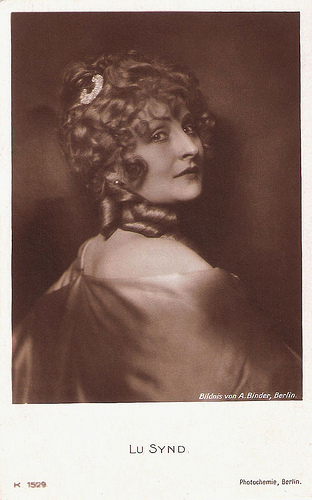
German postcard by Photochemie, Berlin, no. K 1529. Photo: Alex Binder.
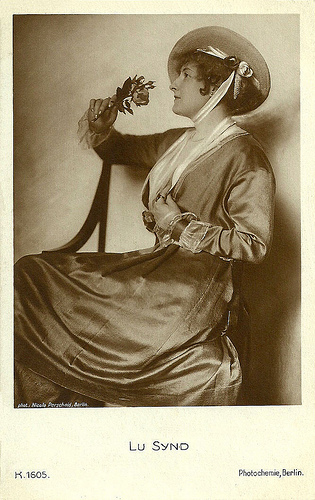
German postcard by Photochemie, Berlin, no. K. 1605. Photo: Nicola Perscheid, Berlin.
Her Own Production Company
Lu Synd was born as Pauline Müller in Konstanz, Germany, in 1886. She was the daughter of a factory owner. She trained as a dancer and performed a.o. in London.
In 1914 she moved to Berlin where she was discovered by film director Richard Eichberg. He gave her her first role in Leben um das Leben/Live for Life (Richard Eichberg, 1916), an Eichberg production starring Ellen Richter .
Lu Synd then launched her own production company Synd film, with which she made three films in a row. The first was Nächte des Grauens/A Night of Horror (1916), directed by Arthur Robison. Besides Synd it co-starred Werner Krauss , Emil Jannings , Hans Mierendorff and Lupu Pick, who would all become well-known actors and directors in the 1920s.
Subsequent films by Synd Film were Die Frau mit den zwei Seelen/The Woman with the Two Souls (Heinrich von Korff, 1916) scripted by Robison; and Das nächste Weib/The Next Wife (Arthur Robison, 1916).
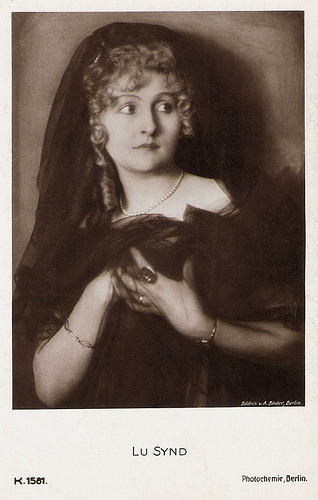
German postcard by Photochemie, Berlin, no. K. 1581. Photo: Alex Binder, Berlin.
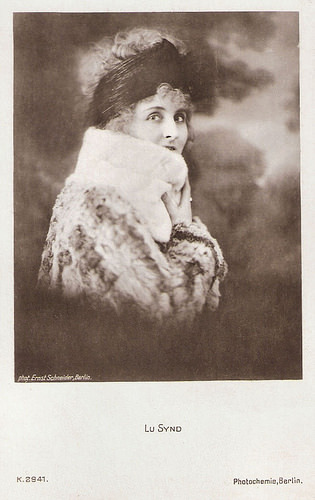
German postcard by Photochemie, Berlin, no. K. 2941. Photo: Ernst Schneider.
Woman Victorious
To Lu Synd's well-known films of the 1910s belong Unsichtbare Hände/Invisible Hands (William Kahn, 1917), the Joe Deebs detective film Europa postlagernd/Poste Restante Europe (E.A. Dupont, 1918) starring Max Landa , Ferdinand Lassalle (Rudolf Meinert, 1918) and Verlorene Töchter/Lost Daughters (William Kahn, 1918).
Other titles were BZ-Maxe & Co. (Otto Rippert, 1916), Die vertauschte Braut/The Changed Bride (1916), Das Spiel vom Tode/The Play with Death (Alwin Neuss, 1917) with Käthe Haack , Der Weg der Erlösung/The Road to Salvation (Joseph Stein, 1918) starring Carl de Vogt , and Die Abenteuer des Kapitän Hansen/The Adventures of Captain Hansen (Harry Piel, 1918).
Rudolf Meinert cast her in his biopic Ferdinand Lassalle, des Volkstribunen Glück und Ende/Ferdinand Lassalle, the tribunes of the people (1918) with Erich Kaiser-Titz as Ferdinand Lassalle, leader of the workers' movement.
In 1919 Aruth Wartan and Lu Synd founded a new film company which produced films in which they starred together: Sündenlust/Desire for Sin (1919), directed by Joseph Delmont and Uwe Jens Krafft; and three films by Delmont: Die Rache des Bastards/The Bastard’s Revenge (1919), Margot de Plaisance (1919) and Der Bastard/The Bastard (1919). Until 1919 Synd was also married to Wartan.
Lu Synd’s last films were Friedrich Feher’s Die letzte Stunde/The Last Hour (1920), and Rennbahnschieber/The Horse Track Slide (Uwe Jens Krafft, 1921), starring Synd and Wartan together again. Between 1919 and 1921 Synd was active in Milan, Italy. She was supposed to act in one Milanese production, La città di vetro/The City of Glass (Eduard Micheroux de Dillon, 1921-1923), but that didn’t happen.
Afterwards Lu’s film career stopped and she concentrated on the stage. She was soon forgotten. Only in the war years she had two bit parts in the films Menschen im Sturm/People in Tempest (Fritz Peter Buch, 1941), staring Gustav Diessl and Olga Tschechowa , and the Marika Rökk film Hab’mich lieb/Love Me (Harald Braun, 1942). Lu Synd died in Berlin in 1978, at the age of 92.
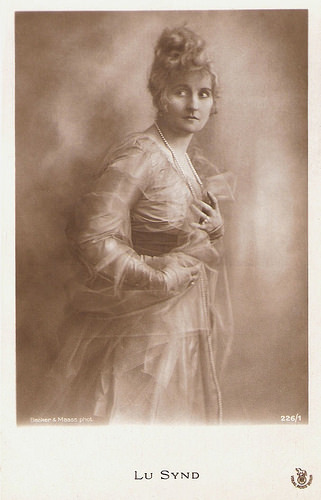
German postcard by Ross-Verlag, Berlin, no. 226/1, 1919-1924. Photo: Becker & Maass.
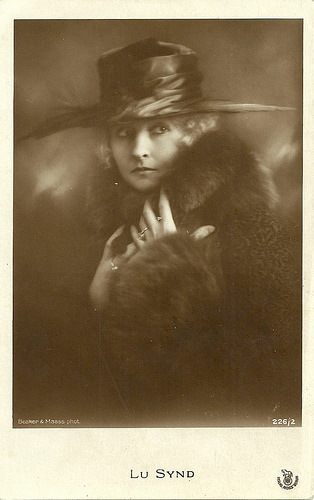
German postcard by Ross-Verlag, Berlin, no. 226/2, 1919-1924. Photo: Becker & Maass.
Sources: Stephanie d'Heil (steffi-Line - German), Thomas Staedeli (Cyranos), Filmportal.de, Wikipedia (German) and .

German postcard by Photochemie, Berlin, no. K 1529. Photo: Alex Binder.

German postcard by Photochemie, Berlin, no. K. 1605. Photo: Nicola Perscheid, Berlin.
Her Own Production Company
Lu Synd was born as Pauline Müller in Konstanz, Germany, in 1886. She was the daughter of a factory owner. She trained as a dancer and performed a.o. in London.
In 1914 she moved to Berlin where she was discovered by film director Richard Eichberg. He gave her her first role in Leben um das Leben/Live for Life (Richard Eichberg, 1916), an Eichberg production starring Ellen Richter .
Lu Synd then launched her own production company Synd film, with which she made three films in a row. The first was Nächte des Grauens/A Night of Horror (1916), directed by Arthur Robison. Besides Synd it co-starred Werner Krauss , Emil Jannings , Hans Mierendorff and Lupu Pick, who would all become well-known actors and directors in the 1920s.
Subsequent films by Synd Film were Die Frau mit den zwei Seelen/The Woman with the Two Souls (Heinrich von Korff, 1916) scripted by Robison; and Das nächste Weib/The Next Wife (Arthur Robison, 1916).

German postcard by Photochemie, Berlin, no. K. 1581. Photo: Alex Binder, Berlin.

German postcard by Photochemie, Berlin, no. K. 2941. Photo: Ernst Schneider.
Woman Victorious
To Lu Synd's well-known films of the 1910s belong Unsichtbare Hände/Invisible Hands (William Kahn, 1917), the Joe Deebs detective film Europa postlagernd/Poste Restante Europe (E.A. Dupont, 1918) starring Max Landa , Ferdinand Lassalle (Rudolf Meinert, 1918) and Verlorene Töchter/Lost Daughters (William Kahn, 1918).
Other titles were BZ-Maxe & Co. (Otto Rippert, 1916), Die vertauschte Braut/The Changed Bride (1916), Das Spiel vom Tode/The Play with Death (Alwin Neuss, 1917) with Käthe Haack , Der Weg der Erlösung/The Road to Salvation (Joseph Stein, 1918) starring Carl de Vogt , and Die Abenteuer des Kapitän Hansen/The Adventures of Captain Hansen (Harry Piel, 1918).
Rudolf Meinert cast her in his biopic Ferdinand Lassalle, des Volkstribunen Glück und Ende/Ferdinand Lassalle, the tribunes of the people (1918) with Erich Kaiser-Titz as Ferdinand Lassalle, leader of the workers' movement.
In 1919 Aruth Wartan and Lu Synd founded a new film company which produced films in which they starred together: Sündenlust/Desire for Sin (1919), directed by Joseph Delmont and Uwe Jens Krafft; and three films by Delmont: Die Rache des Bastards/The Bastard’s Revenge (1919), Margot de Plaisance (1919) and Der Bastard/The Bastard (1919). Until 1919 Synd was also married to Wartan.
Lu Synd’s last films were Friedrich Feher’s Die letzte Stunde/The Last Hour (1920), and Rennbahnschieber/The Horse Track Slide (Uwe Jens Krafft, 1921), starring Synd and Wartan together again. Between 1919 and 1921 Synd was active in Milan, Italy. She was supposed to act in one Milanese production, La città di vetro/The City of Glass (Eduard Micheroux de Dillon, 1921-1923), but that didn’t happen.
Afterwards Lu’s film career stopped and she concentrated on the stage. She was soon forgotten. Only in the war years she had two bit parts in the films Menschen im Sturm/People in Tempest (Fritz Peter Buch, 1941), staring Gustav Diessl and Olga Tschechowa , and the Marika Rökk film Hab’mich lieb/Love Me (Harald Braun, 1942). Lu Synd died in Berlin in 1978, at the age of 92.

German postcard by Ross-Verlag, Berlin, no. 226/1, 1919-1924. Photo: Becker & Maass.

German postcard by Ross-Verlag, Berlin, no. 226/2, 1919-1924. Photo: Becker & Maass.
Sources: Stephanie d'Heil (steffi-Line - German), Thomas Staedeli (Cyranos), Filmportal.de, Wikipedia (German) and .
Published on September 02, 2015 22:00
September 1, 2015
Imported from the USA: Doris Dowling
Doris Dowling (1923-2004) was an American actress who had her breakthrough with Billy Wilder's film The Lost Weekend (1945). Between the late 1940s and early 1950s she acted in a few films in Europe, notably in Riso amaro/Bitter Rice (Giuseppe De Santis, 1949) and Orson Welles' Othello (1952).
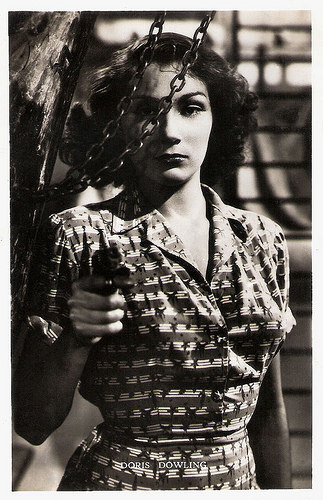
Belgian postcard by Nieuwe Merksemsche Chocolaterie S.P.R.L., Merksem (Anvers). Photo: Lux Film, Rome. Publicity still for Riso amaro/Bitter Rice (Giuseppe de Santis, 1949).
Sobering classic
Doris R. Dowling was born in 1923 in Detroit, Michigan, USA. Her older sister was actress Constance Dowling, who was born in 1920 and died relatively young in 1969.
After some Broadway musical stage work as a chorine, Doris followed Constance to Hollywood and made about an equal representation. Gary Brumburgh at IMDb : "Doris started off auspiciously with the role of the barfly and drinking companion to fellow alcoholic Ray Milland in the sobering classic film The Lost Weekend (1945)." The film, directed by Billy Wilder whom she dated at the time, won the Oscars for Best Picture and Best Actor. It was the first film to deal with the harrowing effects of alcoholism.
Her first credited role led for Doris Dowling to a part as the wife of Alan Ladd in the The Blue Dahlia (George Marshall, 1946) also starring Veronica Lake. Linda Rasmussen at AllMovie: "This neat, fast-paced perfectly cast film noir reflects the hard-boiled, grim wit of the author of its screenplay, Raymond Chandler. Johnny Morrison (Alan Ladd) returns from the war to find his wife Helen (Doris Dowling) having a party and in the arms of another man. Johnny and Helen have a terrible fight, and later Helen is found dead. Johnny must prove his innocence."
She then played the female lead in another Film Noir, The Crimson Key (Eugene Forde, 1947) with Kent Taylor. IMDb-reviewer Mozjoukine: "The second string cast meet the need with Dowling surprisingly glamorous. The small budget doesn't get in the way of a B movie slickness." She also had an uncredited part in Billy Wilder's The Emperor Waltz (1948).
However, no other Hollywood offers followed, Doris decided to leave for Europe, as her sister had done. Constance Dowling had become tired of Hollywood typecasting, and had found a more liberating venue for her talents in the Italian cinema.
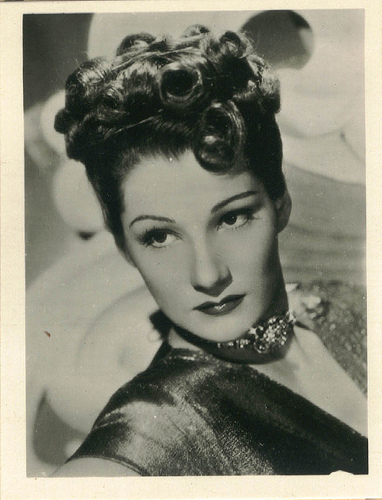
Small collectors card by Greiling in the series Film Stars der Welt, no. C. 174. Collection: Manuel Palomino Arjona @ Flickr. See his Film Stars der Welt album.
Dark, earthy beauty
With her soulful eyes and her dark, earthy beauty, Doris Dowling managed to revive her career in post-war Italy where Neo-Realism had changed the history of the cinema. Films like Roma città aperta/Rome, Open City (Roberto Rossellini, 1945) and Ladri di biciclette/Bicycle Thieves (Vittorio De Sica, 1948) had taken the world by storm, stunned audiences and won awards all over. The themes of the Neorealist film dramas reflected the realities of the Second World War. Dowling found a part as one of the four protagonists of one of the later successes of this film movement, Riso amaro/Bitter Rice (Giuseppe De Santis, 1949).
In Bitter Rice, Dowling plays Francesca, a jewel thief who hides in a rice plantation and joins a band of illegal female workers. Then her partner-in-crime Walter ( Vittorio Gassman ) turns up. While Francesca repents her former life, Walter charms Silvana ( Silvana Mangano ) in becoming his new partner in crime, stealing from the workers. Soldier Marco ( Raf Vallone ) loves Silvana and tries to keep her on the right track but she finds him boring. Francesca instead loves Marco. A fight breaks out in a slaughterhouse, and while the men are both hurt, the women take over...
Bitter Rice became one of the biggest world-wide box-office hits of Neo-Realism. Doris Dowling continued her Italian career with Alina (Giorgio Pastina, 1950) opposite Gina Lollobrigida , and the adventure film Cuori sul mare/Hearts at Sea (Giorgio Bianchi, 1950) with Jacques Sernas .
She also appeared in Orson Welles ' European production of Othello/The Tragedy of Othello: The Moor of Venice (1952) playing the role of Bianca. Dan Jardine at AllMovie : " Welles put together a visually exciting accompaniment to the aural delight of Shakespeare's words. The black-and-white cinematography is sterling, while the aggressively angular shots keep the audience a little off-balance throughout."
She returned to the US and theatre and television comprised much of her later work. She appeared on such popular TV shows as Bonanza (1959), Barnaby Jones (1973) and finally, The Dukes of Hazzard (1984). One of her later films was the cult thriller The Car (Elliot Silverstein, 1977). In 1973, she shared an Outer Critics Circle award for her performance in the all-star stage production of The Women on Broadway. She also served on the Board of Directors for the Los Angeles theatre-based company Theater East.
Doris Dowling died in Los Angeles in 2004. She married three times. From 1952 till 1956, she was wife #7 to band leader Artie Shaw, by whom she had a son, Jonathan Shaw, who became a famous tattoo artist. Second husband was Robert F. Blumofe (1956-1959) and her third was Leonard B. Kaufman (1960-2004; her death) with whom she had her second child.
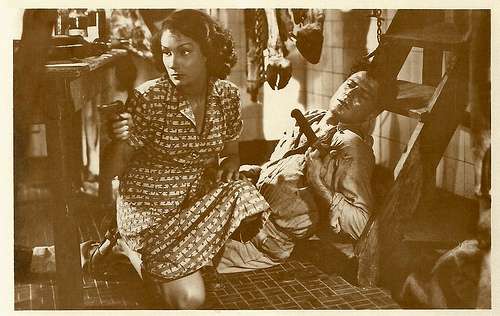
Dutch postcard by Centrafilm, Dordrecht. Photo: Lux Film, Rome. Publicity still for Riso amaro/Bitter Rice (Giuseppe de Santis, 1949) with Raf Vallone .
Trailer Riso amaro/Bitter Rice (Giuseppe de Santis, 1949). Source: CG Entertainment (YouTube).
Sources: (IMDb), Linda Rasmussen (AllMovie), Dan Jardine (AllMovie), Wikipedia and .

Belgian postcard by Nieuwe Merksemsche Chocolaterie S.P.R.L., Merksem (Anvers). Photo: Lux Film, Rome. Publicity still for Riso amaro/Bitter Rice (Giuseppe de Santis, 1949).
Sobering classic
Doris R. Dowling was born in 1923 in Detroit, Michigan, USA. Her older sister was actress Constance Dowling, who was born in 1920 and died relatively young in 1969.
After some Broadway musical stage work as a chorine, Doris followed Constance to Hollywood and made about an equal representation. Gary Brumburgh at IMDb : "Doris started off auspiciously with the role of the barfly and drinking companion to fellow alcoholic Ray Milland in the sobering classic film The Lost Weekend (1945)." The film, directed by Billy Wilder whom she dated at the time, won the Oscars for Best Picture and Best Actor. It was the first film to deal with the harrowing effects of alcoholism.
Her first credited role led for Doris Dowling to a part as the wife of Alan Ladd in the The Blue Dahlia (George Marshall, 1946) also starring Veronica Lake. Linda Rasmussen at AllMovie: "This neat, fast-paced perfectly cast film noir reflects the hard-boiled, grim wit of the author of its screenplay, Raymond Chandler. Johnny Morrison (Alan Ladd) returns from the war to find his wife Helen (Doris Dowling) having a party and in the arms of another man. Johnny and Helen have a terrible fight, and later Helen is found dead. Johnny must prove his innocence."
She then played the female lead in another Film Noir, The Crimson Key (Eugene Forde, 1947) with Kent Taylor. IMDb-reviewer Mozjoukine: "The second string cast meet the need with Dowling surprisingly glamorous. The small budget doesn't get in the way of a B movie slickness." She also had an uncredited part in Billy Wilder's The Emperor Waltz (1948).
However, no other Hollywood offers followed, Doris decided to leave for Europe, as her sister had done. Constance Dowling had become tired of Hollywood typecasting, and had found a more liberating venue for her talents in the Italian cinema.

Small collectors card by Greiling in the series Film Stars der Welt, no. C. 174. Collection: Manuel Palomino Arjona @ Flickr. See his Film Stars der Welt album.
Dark, earthy beauty
With her soulful eyes and her dark, earthy beauty, Doris Dowling managed to revive her career in post-war Italy where Neo-Realism had changed the history of the cinema. Films like Roma città aperta/Rome, Open City (Roberto Rossellini, 1945) and Ladri di biciclette/Bicycle Thieves (Vittorio De Sica, 1948) had taken the world by storm, stunned audiences and won awards all over. The themes of the Neorealist film dramas reflected the realities of the Second World War. Dowling found a part as one of the four protagonists of one of the later successes of this film movement, Riso amaro/Bitter Rice (Giuseppe De Santis, 1949).
In Bitter Rice, Dowling plays Francesca, a jewel thief who hides in a rice plantation and joins a band of illegal female workers. Then her partner-in-crime Walter ( Vittorio Gassman ) turns up. While Francesca repents her former life, Walter charms Silvana ( Silvana Mangano ) in becoming his new partner in crime, stealing from the workers. Soldier Marco ( Raf Vallone ) loves Silvana and tries to keep her on the right track but she finds him boring. Francesca instead loves Marco. A fight breaks out in a slaughterhouse, and while the men are both hurt, the women take over...
Bitter Rice became one of the biggest world-wide box-office hits of Neo-Realism. Doris Dowling continued her Italian career with Alina (Giorgio Pastina, 1950) opposite Gina Lollobrigida , and the adventure film Cuori sul mare/Hearts at Sea (Giorgio Bianchi, 1950) with Jacques Sernas .
She also appeared in Orson Welles ' European production of Othello/The Tragedy of Othello: The Moor of Venice (1952) playing the role of Bianca. Dan Jardine at AllMovie : " Welles put together a visually exciting accompaniment to the aural delight of Shakespeare's words. The black-and-white cinematography is sterling, while the aggressively angular shots keep the audience a little off-balance throughout."
She returned to the US and theatre and television comprised much of her later work. She appeared on such popular TV shows as Bonanza (1959), Barnaby Jones (1973) and finally, The Dukes of Hazzard (1984). One of her later films was the cult thriller The Car (Elliot Silverstein, 1977). In 1973, she shared an Outer Critics Circle award for her performance in the all-star stage production of The Women on Broadway. She also served on the Board of Directors for the Los Angeles theatre-based company Theater East.
Doris Dowling died in Los Angeles in 2004. She married three times. From 1952 till 1956, she was wife #7 to band leader Artie Shaw, by whom she had a son, Jonathan Shaw, who became a famous tattoo artist. Second husband was Robert F. Blumofe (1956-1959) and her third was Leonard B. Kaufman (1960-2004; her death) with whom she had her second child.

Dutch postcard by Centrafilm, Dordrecht. Photo: Lux Film, Rome. Publicity still for Riso amaro/Bitter Rice (Giuseppe de Santis, 1949) with Raf Vallone .
Trailer Riso amaro/Bitter Rice (Giuseppe de Santis, 1949). Source: CG Entertainment (YouTube).
Sources: (IMDb), Linda Rasmussen (AllMovie), Dan Jardine (AllMovie), Wikipedia and .
Published on September 01, 2015 22:00
August 31, 2015
Mario Adorf
For over 55 years the Swiss actor Mario Adorf (1930) is a very active star of the European cinema, known for his Mediterranean looks, his dark oily frizzy hair and his imposing figure. He started as a talented newcomer in German films of the 1950s, he hammed his way through the 1960s as a villain in Euro-Westerns and action pictures, but he is now best known for his roles in some classics of the Junge Deutsche Film such as Die Blechtrommel/The Tin Drum (1978) and Lola (1981). He appeared in over 200 films and TV films.
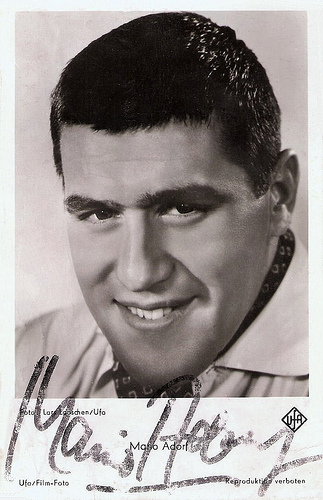
German postcard by Ufa/Film-Foto, Berlin-Tempelhof, no. PK 4083. Retail price: 25 Pfg. Photo: Lars Looschen / Ufa.
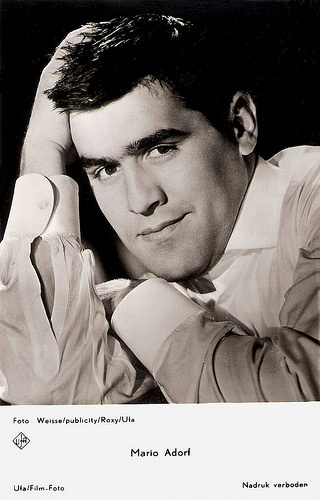
Dutch postcard by Gebr. Spanjersberg N.V., Rotterdam, no. 4745. Photo: Weisse / publicity / Roxy / Ufa.
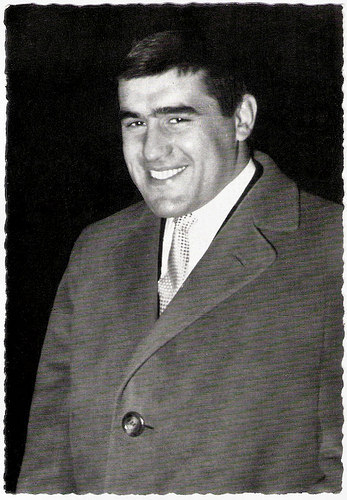
German postcard by WS-Druck, Wanne-Eickel, no. 341. Photo: Erwin Schneider.
An Ideal Villain
Mario Adorf was born in Zürich, Switzerland, in 1930. He was the illegitimate son of Dr. Matteo Menniti, an Italian surgeon, and Alice Adorf, a German nurse. He grew up in his maternal grandfather's hometown, Mayen in the Eifel, Germany, where he was raised by his unmarried mother. He studied at the Universität Mainz and studied drama at the famous Otto-Falckenberg-Schule in München (Munich).
He was still studying drama when he made his film debut as a German soldier in the first instalment of the war trilogy 08/15 (Paul May, 1954). It was a small part but it didn't go unnoticed and got him new roles in German films.
He played a a starring part in Das Mädchen Rosemarie/The Girl Rosemary (Rolf Thiele, 1958) with Nadja Tiller . His most remarkable role of this period was Bruno Lüdke, the mentally defective serial killer in the masterpiece Nachts, wenn der Teufel kam/The Devil Strikes at Night (Robert Siodmak, 1957). It earned him his first award, the Bundesfilmpreis (German film award for outstanding young actor).
Adorf became known in Europe, and particularly in Germany. His films included the psychological thriller Die Schachnovelle/Brainwashed (Gerd Oswald, 1960) with Curd Jürgens , and the popular Karl May Western Winnetou I/Apache Gold (Harald Reinl, 1963), in which he played Santer, the bad guy who shot Winnetou’s sister Ntscho-tschi ( Marie Versini ).
In the early 1960s, Adorf moved to Rome. Spaghetti Western aficionados remember him probably best for his role as 'El Diablo' in Gli Specialisti /Drop Them or I'll Shoot (Sergio Corbucci, 1969) with Johnny Hallyday .
He also appeared in such English language films as Major Dundee (Sam Peckinpah, 1965) and the Agatha Christie mystery Ten Little Indians (George Pollock, 1965). He later turned down a role as General Mapache in Sam Peckinpah's The Wild Bunch, because he felt the character was too violent. It would be a decision he still deeply regrets.
At IMDb , Guy Bellinger comments: “His Mediterranean looks, his rugged face, his dark oily frizzy hair and his volubility made him an ideal villain in European-made westerns, spy or mafia films. These films - made in the 1960’s - were mostly just commercial and Adorf hammed his parts but he did it so brilliantly that he alone made them watchable.”
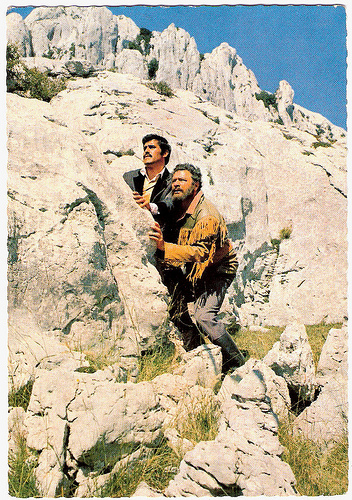
German postcard. Photo: Constantin. Still from Winnetou - 1. Teil/Apache Gold (Harald Reinl, 1963).
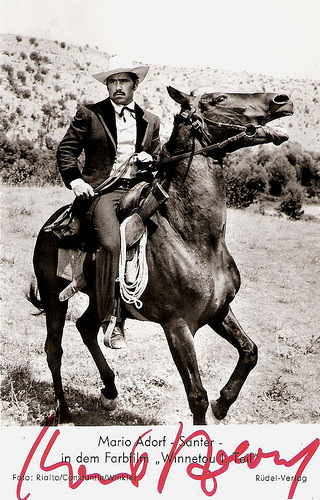
German postcard by Rüdel-Verlag, no. 3930. Photo: Rialto / Constantin / Winkler. Publicity still for Winnetou - 1. Teil/Apache Gold (Harald Reinl, 1963).
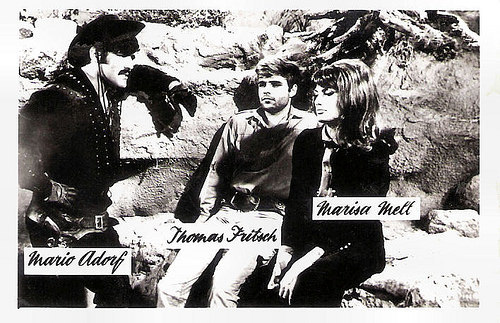
Small Romanian collectors card by Casa Filmului Acin. Photo: publicity still for Der letzte Ritt nach Santa Cruz/The Last Ride to Santa Cruz (Rolf Olsen, 1964) with Thomas Fritsch and Marisa Mell.
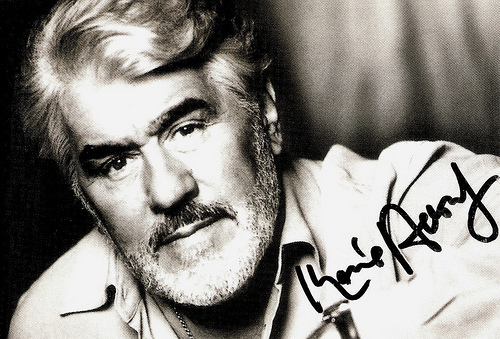
German autograph card.
The Young German Cinema
From the 1970s on, the quality of his films improved and Mario Adorf could lend his remarkable acting talents to more ambitious works such as Il Delitto Matteotti/The Assassination of Matteoti (Florestano Vancini, 1973) in which he was a striking Benito Mussolini.
Though he worked steadily through the decade, Adorf did not really come to prominence until he appeared in such major features of Der Junge Deutsche Film (The Young German Cinema) as Die Verlorene Ehre der Katharina Blum/The Lost Honor of Katharina Blum (Margarethe von Trotta, Volker Schlöndorff, 1975 and Die Blechtrommel/The Tin Drum (Volker Schlöndorff, 1979).
Lucia Bozzola writes at AllMovie about the latter film: “New German Cinema forefather Volker Schlöndorff's adaptation of The Tin Drum is a potent Fellini-esque epic of intuitive rebellion against a corrupt world. Shot on location in Poland, Germany, and France, the film mixes the palpable reality of ordinary life in prewar and World War II Danzig with the surreal, innocent perspective of stunted boy/man Oskar as he raises instinctive hell against the horrors he witnesses, first in his family and then as the Nazis take over his hometown. Reaching the heights of comedy in a chaotic Nazi rally and the depths of tragedy during the Danzig post-office siege, ”. It was one of the most financially successful German films of the 1970s and won the 1979 Oscar for Best Foreign Film and the Palme d’Or (Golden Palm) at the 1979 Cannes Film festival.
Mario Adorf also worked with Rainer Werner Fassbinder at Lola (1981) featuring Barbara Sukowa.
On TV he played a small role in the BBC adaptation of John le Carré's Smiley's People (Simon Langton, 1982) as a German club owner. In Italy he was the main protagonist of the TV series Zu Gin (1985), as well as of numerous films.
Adorf worked with an impressive list of directors, including Wolfgang Staudte, Billy Wilder, John Frankenheimer, and Claude Chabrol. Likewise he served many a great author, either in the theatre (such as in William Shakespeare’s Othello, or in Tennessee Williams’ A Streetcar Named Desire) or on the big or small screen (Heinrich Böll, Arthur Schnitzler, Henry Miller, Joseph Conrad, Maxim Gorky, Patrick Süskind).
In the 1990s he changed his image and became the patriarch in such TV-films as Der grosse Bellheim/The Great Bellheim (Dieter Wedel, 1993). He also made appearances in international films, including Smilla's Sense of Snow (Bille August, 1997).
In 1994, he started a singing career with his solo program Al Dente, and he wrote five novels, including the bestsellers Der Mäusetöter (The Mice Killer, 1992) and Der Dieb von Trastevere (The Thief of Trastevere, 1995). In 2005, he published Mit einer Nadel bloß (With just one needle), a memoir about his mother.
In 1963, Adorf married Lis Verhoeven. The couple had a child, Stella, prior to their divorce. In 1985, he married Monique Faye, with whom he is still married. In 2000, he was honoured with the Bayerischer Filmpreis (Bavarian Film Awards Honorary Award), and a year later with the Großes Bundesverdienstkreuz (Germany's Cross of merit).
In his 80s now, Mario Adorf remains very active in German films, television, and theatre. His more recent pictures include Grapes of Hope (Tunc Okan, 2010) and the comedy Altersglühen - Speed Dating für Senioren/Old glow - Speeddating for Seniors (Jan Georg Schütte, 2014) in which he costarred with Senta Berger .
German trailer for Winnetou I/Apache Gold (1963). Source: Rialto Film (YouTube).
Trailer for Die Blechtrommel/The Tin Drum (1979). Source: DionysusCinema (YouTube).
German trailer for Lola (1981). Source: Rialto Film (YouTube).
Sources: (IMDb), Sandra Brennan (AllMovie), Lucia Bozzola (AllMovie), Tom B. (Westerns all Italiana), marioadorf.com (German), Wikipedia, and .

German postcard by Ufa/Film-Foto, Berlin-Tempelhof, no. PK 4083. Retail price: 25 Pfg. Photo: Lars Looschen / Ufa.

Dutch postcard by Gebr. Spanjersberg N.V., Rotterdam, no. 4745. Photo: Weisse / publicity / Roxy / Ufa.

German postcard by WS-Druck, Wanne-Eickel, no. 341. Photo: Erwin Schneider.
An Ideal Villain
Mario Adorf was born in Zürich, Switzerland, in 1930. He was the illegitimate son of Dr. Matteo Menniti, an Italian surgeon, and Alice Adorf, a German nurse. He grew up in his maternal grandfather's hometown, Mayen in the Eifel, Germany, where he was raised by his unmarried mother. He studied at the Universität Mainz and studied drama at the famous Otto-Falckenberg-Schule in München (Munich).
He was still studying drama when he made his film debut as a German soldier in the first instalment of the war trilogy 08/15 (Paul May, 1954). It was a small part but it didn't go unnoticed and got him new roles in German films.
He played a a starring part in Das Mädchen Rosemarie/The Girl Rosemary (Rolf Thiele, 1958) with Nadja Tiller . His most remarkable role of this period was Bruno Lüdke, the mentally defective serial killer in the masterpiece Nachts, wenn der Teufel kam/The Devil Strikes at Night (Robert Siodmak, 1957). It earned him his first award, the Bundesfilmpreis (German film award for outstanding young actor).
Adorf became known in Europe, and particularly in Germany. His films included the psychological thriller Die Schachnovelle/Brainwashed (Gerd Oswald, 1960) with Curd Jürgens , and the popular Karl May Western Winnetou I/Apache Gold (Harald Reinl, 1963), in which he played Santer, the bad guy who shot Winnetou’s sister Ntscho-tschi ( Marie Versini ).
In the early 1960s, Adorf moved to Rome. Spaghetti Western aficionados remember him probably best for his role as 'El Diablo' in Gli Specialisti /Drop Them or I'll Shoot (Sergio Corbucci, 1969) with Johnny Hallyday .
He also appeared in such English language films as Major Dundee (Sam Peckinpah, 1965) and the Agatha Christie mystery Ten Little Indians (George Pollock, 1965). He later turned down a role as General Mapache in Sam Peckinpah's The Wild Bunch, because he felt the character was too violent. It would be a decision he still deeply regrets.
At IMDb , Guy Bellinger comments: “His Mediterranean looks, his rugged face, his dark oily frizzy hair and his volubility made him an ideal villain in European-made westerns, spy or mafia films. These films - made in the 1960’s - were mostly just commercial and Adorf hammed his parts but he did it so brilliantly that he alone made them watchable.”

German postcard. Photo: Constantin. Still from Winnetou - 1. Teil/Apache Gold (Harald Reinl, 1963).

German postcard by Rüdel-Verlag, no. 3930. Photo: Rialto / Constantin / Winkler. Publicity still for Winnetou - 1. Teil/Apache Gold (Harald Reinl, 1963).

Small Romanian collectors card by Casa Filmului Acin. Photo: publicity still for Der letzte Ritt nach Santa Cruz/The Last Ride to Santa Cruz (Rolf Olsen, 1964) with Thomas Fritsch and Marisa Mell.

German autograph card.
The Young German Cinema
From the 1970s on, the quality of his films improved and Mario Adorf could lend his remarkable acting talents to more ambitious works such as Il Delitto Matteotti/The Assassination of Matteoti (Florestano Vancini, 1973) in which he was a striking Benito Mussolini.
Though he worked steadily through the decade, Adorf did not really come to prominence until he appeared in such major features of Der Junge Deutsche Film (The Young German Cinema) as Die Verlorene Ehre der Katharina Blum/The Lost Honor of Katharina Blum (Margarethe von Trotta, Volker Schlöndorff, 1975 and Die Blechtrommel/The Tin Drum (Volker Schlöndorff, 1979).
Lucia Bozzola writes at AllMovie about the latter film: “New German Cinema forefather Volker Schlöndorff's adaptation of The Tin Drum is a potent Fellini-esque epic of intuitive rebellion against a corrupt world. Shot on location in Poland, Germany, and France, the film mixes the palpable reality of ordinary life in prewar and World War II Danzig with the surreal, innocent perspective of stunted boy/man Oskar as he raises instinctive hell against the horrors he witnesses, first in his family and then as the Nazis take over his hometown. Reaching the heights of comedy in a chaotic Nazi rally and the depths of tragedy during the Danzig post-office siege, ”. It was one of the most financially successful German films of the 1970s and won the 1979 Oscar for Best Foreign Film and the Palme d’Or (Golden Palm) at the 1979 Cannes Film festival.
Mario Adorf also worked with Rainer Werner Fassbinder at Lola (1981) featuring Barbara Sukowa.
On TV he played a small role in the BBC adaptation of John le Carré's Smiley's People (Simon Langton, 1982) as a German club owner. In Italy he was the main protagonist of the TV series Zu Gin (1985), as well as of numerous films.
Adorf worked with an impressive list of directors, including Wolfgang Staudte, Billy Wilder, John Frankenheimer, and Claude Chabrol. Likewise he served many a great author, either in the theatre (such as in William Shakespeare’s Othello, or in Tennessee Williams’ A Streetcar Named Desire) or on the big or small screen (Heinrich Böll, Arthur Schnitzler, Henry Miller, Joseph Conrad, Maxim Gorky, Patrick Süskind).
In the 1990s he changed his image and became the patriarch in such TV-films as Der grosse Bellheim/The Great Bellheim (Dieter Wedel, 1993). He also made appearances in international films, including Smilla's Sense of Snow (Bille August, 1997).
In 1994, he started a singing career with his solo program Al Dente, and he wrote five novels, including the bestsellers Der Mäusetöter (The Mice Killer, 1992) and Der Dieb von Trastevere (The Thief of Trastevere, 1995). In 2005, he published Mit einer Nadel bloß (With just one needle), a memoir about his mother.
In 1963, Adorf married Lis Verhoeven. The couple had a child, Stella, prior to their divorce. In 1985, he married Monique Faye, with whom he is still married. In 2000, he was honoured with the Bayerischer Filmpreis (Bavarian Film Awards Honorary Award), and a year later with the Großes Bundesverdienstkreuz (Germany's Cross of merit).
In his 80s now, Mario Adorf remains very active in German films, television, and theatre. His more recent pictures include Grapes of Hope (Tunc Okan, 2010) and the comedy Altersglühen - Speed Dating für Senioren/Old glow - Speeddating for Seniors (Jan Georg Schütte, 2014) in which he costarred with Senta Berger .
German trailer for Winnetou I/Apache Gold (1963). Source: Rialto Film (YouTube).
Trailer for Die Blechtrommel/The Tin Drum (1979). Source: DionysusCinema (YouTube).
German trailer for Lola (1981). Source: Rialto Film (YouTube).
Sources: (IMDb), Sandra Brennan (AllMovie), Lucia Bozzola (AllMovie), Tom B. (Westerns all Italiana), marioadorf.com (German), Wikipedia, and .
Published on August 31, 2015 22:00
August 30, 2015
Anita Janousková
Hungarian actress Anita Janousková or Anita Janová (1907-1965) was one of the first stars of the Czech cinema. She appeared in more than a dozen Czech silent films during the late 1920s.
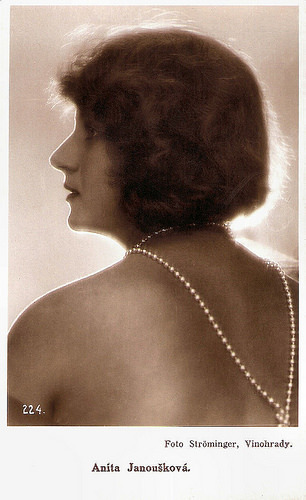
Czech postcard, no. 224. Photo: Ströminger, Vinohrady.
A remarkably successful film career
Anita Janousková was born in 1907 in Vienna, Austria-Hungary as Anna Janousková. Anita started her career in the theatre, but soon would have a remarkably successful film career in the silent Czech cinema.
In 1926, she probably made her film debut with the lead role role of the young and ambitious Helenka, daughter of an old forester (Ferdinand Kaňkovský) in the romance Pohádka máje/May Fairy Tale (Karl Anton, 1926). It is a lyrical tale of the pure romance between Anita's character and a fairly dissolute, but kind-hearted law student from Prague (Petr Dolan a.k.a. Jiri Voskovec).
This debut was not a case of single luck. The following years, she played supporting parts like in the hilarious comedy Anicko, vrat se!/Anny, come back! (Theodor Pistek, 1927), featuring Anny Ondra and Carl Lamac. Her fair hair, cute face, sharp eyes and smiling lips made her a popular silent film star in Prague.
Anita became the leading lady of Czech films like Sextánka (Josef Medeotti-Bohác, 1928), Filosofka Mája/Philosopher Maja (Oldrich Kmínek, 1928) and Andelíckárka/Abortionist (Oldrich Kmínek, 1930). In these films she was always credited as Anita Janová.
In the early 1930s her film career halted. Her two sound films were failures. She married and retired completely. Between 1935 and 1945 she lived in the Slovak Republic.
Twenty years after her last film, she returned to the screen. During the 1950s, she played several small roles in films like Mladá léta/Youthful Years (Václav Krska, 1953). In 1975, Anita Janousková, one of the first stars of the Czech cinema died forgotten and in seclusion in Prague. She was 67.
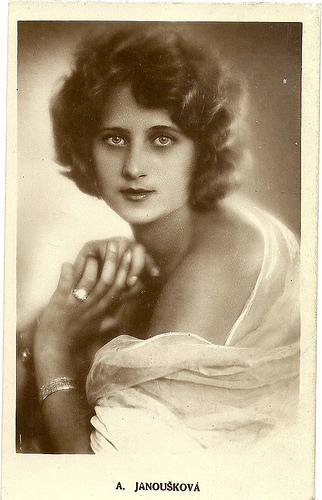
Vintage postcard. Collection: Didier Hanson.
Source: Jarda "Kribi" Lopour (CSFD - Czech), and .

Czech postcard, no. 224. Photo: Ströminger, Vinohrady.
A remarkably successful film career
Anita Janousková was born in 1907 in Vienna, Austria-Hungary as Anna Janousková. Anita started her career in the theatre, but soon would have a remarkably successful film career in the silent Czech cinema.
In 1926, she probably made her film debut with the lead role role of the young and ambitious Helenka, daughter of an old forester (Ferdinand Kaňkovský) in the romance Pohádka máje/May Fairy Tale (Karl Anton, 1926). It is a lyrical tale of the pure romance between Anita's character and a fairly dissolute, but kind-hearted law student from Prague (Petr Dolan a.k.a. Jiri Voskovec).
This debut was not a case of single luck. The following years, she played supporting parts like in the hilarious comedy Anicko, vrat se!/Anny, come back! (Theodor Pistek, 1927), featuring Anny Ondra and Carl Lamac. Her fair hair, cute face, sharp eyes and smiling lips made her a popular silent film star in Prague.
Anita became the leading lady of Czech films like Sextánka (Josef Medeotti-Bohác, 1928), Filosofka Mája/Philosopher Maja (Oldrich Kmínek, 1928) and Andelíckárka/Abortionist (Oldrich Kmínek, 1930). In these films she was always credited as Anita Janová.
In the early 1930s her film career halted. Her two sound films were failures. She married and retired completely. Between 1935 and 1945 she lived in the Slovak Republic.
Twenty years after her last film, she returned to the screen. During the 1950s, she played several small roles in films like Mladá léta/Youthful Years (Václav Krska, 1953). In 1975, Anita Janousková, one of the first stars of the Czech cinema died forgotten and in seclusion in Prague. She was 67.

Vintage postcard. Collection: Didier Hanson.
Source: Jarda "Kribi" Lopour (CSFD - Czech), and .
Published on August 30, 2015 22:00
August 29, 2015
Samantha Eggar
Auburn-haired beauty Samantha Eggar (1939) is a gifted English film, television and voice actress. She played in several Hollywood movies, including the acclaimed psychological thriller The Collector (William Wyler, 1965), but somehow never managed to become a major star.
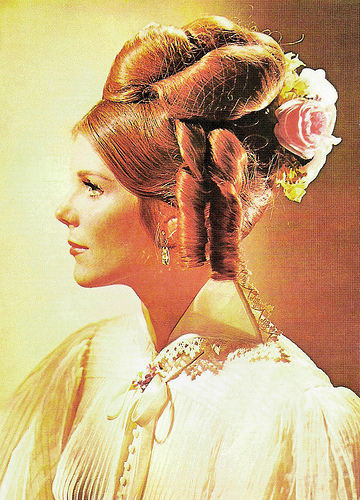
Romanian postcard by Casa Filmului Acin.
The Collector
Samantha Eggar was born Victoria Louise Samantha Marie Elizabeth Therese Eggar in 1939 in Hampstead, London. Her parents were Ralph Eggar, a brigadier in the British Army, and his wife Muriel Eggar, of Dutch and Portuguese descent. Eggar was brought up as a Roman Catholic and educated at St Mary's Providence Convent in Surrey.
While at boarding school, she was given the opportunity to thrive in the arts, in school plays, in musical concerts and poetry competitions. After graduating from art school, she was accepted at the Webber Douglas School for Drama in London. Before finishing the two-year program at Webber Douglas, she was offered the role of Lady Hamilton in a play written by photographer Cecil Beaton.
She played in several Shakespearean companies and on television. While performing onstage at the Royal Court Theatre, film producer Betty Box spotted her. Box cast her in the film The Wild and the Willing (Ralph Thomas, 1962), a romantic drama about a group of students at university. She played a sluttish college coed opposite Ian McShane and John Hurt.
After this film debut she played in Dr. Crippen (Robert Lynn, 1962) as Ethel Le Neve, Crippen's mistress. Donald Pleasence starred as the real-life Edwardian doctor Hawley Harvey Crippen who was hanged in 1910 for the murder of his wife. In 1963, Eggar played the title character in the episode Marcia of the TV series The Saint, featuring Roger Moore . After her appearance in The Saint, Eggar did not appear in television for ten years, instead focusing exclusively on feature films. In England she made the thriller Return from the Ashes (J. Lee Thompson, 1965) with Maximilian Schell , Ingrid Thulin and Herbert Lom.
She received a nomination for the Academy Award for Best Actress for her role of kidnap victim Miranda Grey opposite Terence Stamp in the American psychological thriller The Collector (William Wyler, 1965). Brendon Hanley at AllMovie : “The success of The Collector depends almost entirely on its two stars, Terence Stamp and Samantha Eggar, since scarcely anyone else is in the movie.” Eggar won a Golden Globe award for this performance and was also named Best Actress at the Cannes Film Festival.
Eggar then starred in the Cary Grant comedy Walk, Don't Run (Charles Walters, 1966), set in Tokyo during the Olympic Games in 1964. It was the last appearance by Grant in a feature film, and also director Walters last film. Her next Hollywood production was the musical Doctor Dolittle (Richard Fleischer, 1967) starring Rex Harrison . The film received generally mixed critical reviews, but through 20th Century Fox's intense lobbying, was nominated for the Academy Award for Best Picture and won awards for Best Original Song and Best Visual Effects.
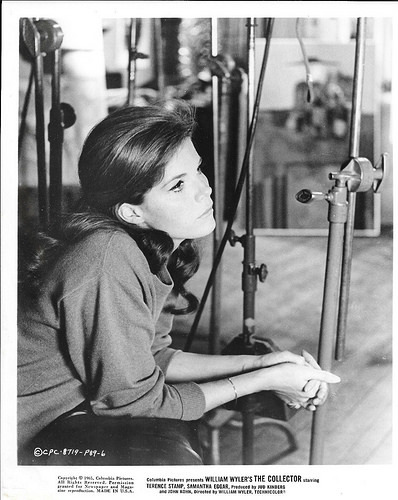
Publicity still for The Collector (William Wyler, 1965). Source: RetroGlamour Fan (Flickr).
The Brood
Samantha Eggar appeared opposite Richard Harris and Sean Connery in the American production The Molly Maguires (Martin Ritt, 1970). Set in late 19th century Northeastern Pennsylvania, this social drama tells the story of an undercover detective sent to a coal mining community to expose a secret society of Irish-American miners battling exploitation at the hand of the owners. Partly inspired by a true story, the film portrays the rebellious leader of the Molly Maguires and his will to achieve social justice. The film was considered a major box-office failure.
Another commercial flop was the adventure film The Light at the Edge of the World (Kevin Billington, 1971), starring Yul Brynner and Kirk Douglas. The plot, adapted from Jules Verne's novel Le Phare du bout du monde (1905), involves piracy in the South Atlantic during the mid 19th century, with a theme of survival in extreme circumstances, and events centering on an isolated lighthouse.
Next, she starred in the Italian Giallo L'etrusco uccide ancora/The Dead Are Alive (Armando Crispino, 1972) with Alex Cord and Nadja Tiller , and the American psychological thrille A Name for Evil (Bernard Girard, 1973) with Robert Culp. Eggar co-starred again with Yul Brynner in the television series Anna and the King (1972). She also starred in the episode The Cardboard House of the romantic anthology series Love Story (1973).
Returning to the British Stage, she starred with Anthony Hopkins and Colin Firth in Arthur Schnitzler's The Lonely Road and reunited with John Hurt in Anton Chekhov's The Seagull. In 1976, she co-starred with Peter Falk and Theodore Bikel in the Columbo episode The Bye-Bye Sky High IQ Murder Case. That same year, she also appeared in the Sherlock Holmes film The Seven-Per-Cent Solution (Herbert Ross, 1976), playing the wife of Dr. Watson (Robert Duvall).
A highlight in her later career is her volcanic performance in David Cronenberg's early masterpiece The Brood (1979). Art Hindle plays a man who tries to uncover an unconventional psychologist's (Oliver Reed) therapy techniques on his institutionalized wife (Eggar). A series of brutal attacks committed by a brood of mutant children coincides with the husband's investigation. Brian J. Dillard at AllMovie : “Samantha Eggar's haughty, self-obsessed Nola, meanwhile, establishes the Cronenberg ice-queen archetype that Genevieve Bujold would fill so indelibly in Dead Ringers. Although hardly the most influential of the director's early and mid-period horror exercises, The Brood stands up as a fully realized study of modern discontent given terrifying shape.”
Trailer for The Brood (David Cronenberg, 1979). Source: Film&Clips (YouTube).
Hercules’ mother
During the next decades, the bulk of Samantha Eggar's screen work would be on television in series like Murder, She Wrote (1984) with Angela Lansbury, Magnum, P.I. (1984), Tales of the Unexpected (1985), Matlock (1990), and as the wife of Captain Jean-Luc Picard's brother Robert in Star Trek: The Next Generation (1990).
She also appeared as Maggie Gioberti in The Vintage Years (1981), the unaired pilot for the prime-time soap opera Falcon Crest, but was replaced by Susan Sullivan when the series went into production.
Her later films include the Canadian cult horror film Curtains (Richard Ciupka, 1983) about a group of actresses targeted by a masked killer at a prestigious director's (John Vernon) remote mansion where they are auditioning for a film role, and the American superhero film The Phantom (Simon Wincer, 1996) featuring Billy Zane.
In 1997, she provided the voice of Hera, Hercules’ mother, in Disney's animated musical fantasy Hercules (Ton Clements, John Musker, 1997). Eggar also had a role in the American science fiction thriller The Astronaut's Wife (Rand Ravich, 1999), which starred Johnny Depp and Charlize Theron.
On TV, she appeared as Sarah Templeton, the wife of Speaker of the House Nathan Templeton (Donald Sutherland), on the short-lived television series Commander in Chief, which starred Geena Davis.
In 2000, she had a brief run in the American soap opera All My Children. Later she did guest-appearances in the TV series Cold Case (2003) and Mental (2009).
Samantha Eggar was married to actor-director Tom Stern from 1964 till 1971. They have two children, Nicholas Stern, and Jenna Stern. Nicolas works in film production, and Jenna-Louise is an actress. Samantha Eggar has appeared in over 90 films and television series. She continues to work these days, as a member of California Artists Radio Theatre, as well as voicework and television appearances.
Trailer for The Collector (William Wyler, 1965). Source: W. David Lindholm (YouTube).
Trailer The Light At The Edge Of The World Trailer (Kevin Billington, 1971). Source: Video Detective (YouTube).
Sources: SamanthaEggar.net, Brian McFarlane (Encyclopedia of British Film), Brendon Hanley (AllMovie), Brian J. Dillard (AllMovie), Hal Erickson (AllMovie), The Terror Trap, Wikipedia and .

Romanian postcard by Casa Filmului Acin.
The Collector
Samantha Eggar was born Victoria Louise Samantha Marie Elizabeth Therese Eggar in 1939 in Hampstead, London. Her parents were Ralph Eggar, a brigadier in the British Army, and his wife Muriel Eggar, of Dutch and Portuguese descent. Eggar was brought up as a Roman Catholic and educated at St Mary's Providence Convent in Surrey.
While at boarding school, she was given the opportunity to thrive in the arts, in school plays, in musical concerts and poetry competitions. After graduating from art school, she was accepted at the Webber Douglas School for Drama in London. Before finishing the two-year program at Webber Douglas, she was offered the role of Lady Hamilton in a play written by photographer Cecil Beaton.
She played in several Shakespearean companies and on television. While performing onstage at the Royal Court Theatre, film producer Betty Box spotted her. Box cast her in the film The Wild and the Willing (Ralph Thomas, 1962), a romantic drama about a group of students at university. She played a sluttish college coed opposite Ian McShane and John Hurt.
After this film debut she played in Dr. Crippen (Robert Lynn, 1962) as Ethel Le Neve, Crippen's mistress. Donald Pleasence starred as the real-life Edwardian doctor Hawley Harvey Crippen who was hanged in 1910 for the murder of his wife. In 1963, Eggar played the title character in the episode Marcia of the TV series The Saint, featuring Roger Moore . After her appearance in The Saint, Eggar did not appear in television for ten years, instead focusing exclusively on feature films. In England she made the thriller Return from the Ashes (J. Lee Thompson, 1965) with Maximilian Schell , Ingrid Thulin and Herbert Lom.
She received a nomination for the Academy Award for Best Actress for her role of kidnap victim Miranda Grey opposite Terence Stamp in the American psychological thriller The Collector (William Wyler, 1965). Brendon Hanley at AllMovie : “The success of The Collector depends almost entirely on its two stars, Terence Stamp and Samantha Eggar, since scarcely anyone else is in the movie.” Eggar won a Golden Globe award for this performance and was also named Best Actress at the Cannes Film Festival.
Eggar then starred in the Cary Grant comedy Walk, Don't Run (Charles Walters, 1966), set in Tokyo during the Olympic Games in 1964. It was the last appearance by Grant in a feature film, and also director Walters last film. Her next Hollywood production was the musical Doctor Dolittle (Richard Fleischer, 1967) starring Rex Harrison . The film received generally mixed critical reviews, but through 20th Century Fox's intense lobbying, was nominated for the Academy Award for Best Picture and won awards for Best Original Song and Best Visual Effects.

Publicity still for The Collector (William Wyler, 1965). Source: RetroGlamour Fan (Flickr).
The Brood
Samantha Eggar appeared opposite Richard Harris and Sean Connery in the American production The Molly Maguires (Martin Ritt, 1970). Set in late 19th century Northeastern Pennsylvania, this social drama tells the story of an undercover detective sent to a coal mining community to expose a secret society of Irish-American miners battling exploitation at the hand of the owners. Partly inspired by a true story, the film portrays the rebellious leader of the Molly Maguires and his will to achieve social justice. The film was considered a major box-office failure.
Another commercial flop was the adventure film The Light at the Edge of the World (Kevin Billington, 1971), starring Yul Brynner and Kirk Douglas. The plot, adapted from Jules Verne's novel Le Phare du bout du monde (1905), involves piracy in the South Atlantic during the mid 19th century, with a theme of survival in extreme circumstances, and events centering on an isolated lighthouse.
Next, she starred in the Italian Giallo L'etrusco uccide ancora/The Dead Are Alive (Armando Crispino, 1972) with Alex Cord and Nadja Tiller , and the American psychological thrille A Name for Evil (Bernard Girard, 1973) with Robert Culp. Eggar co-starred again with Yul Brynner in the television series Anna and the King (1972). She also starred in the episode The Cardboard House of the romantic anthology series Love Story (1973).
Returning to the British Stage, she starred with Anthony Hopkins and Colin Firth in Arthur Schnitzler's The Lonely Road and reunited with John Hurt in Anton Chekhov's The Seagull. In 1976, she co-starred with Peter Falk and Theodore Bikel in the Columbo episode The Bye-Bye Sky High IQ Murder Case. That same year, she also appeared in the Sherlock Holmes film The Seven-Per-Cent Solution (Herbert Ross, 1976), playing the wife of Dr. Watson (Robert Duvall).
A highlight in her later career is her volcanic performance in David Cronenberg's early masterpiece The Brood (1979). Art Hindle plays a man who tries to uncover an unconventional psychologist's (Oliver Reed) therapy techniques on his institutionalized wife (Eggar). A series of brutal attacks committed by a brood of mutant children coincides with the husband's investigation. Brian J. Dillard at AllMovie : “Samantha Eggar's haughty, self-obsessed Nola, meanwhile, establishes the Cronenberg ice-queen archetype that Genevieve Bujold would fill so indelibly in Dead Ringers. Although hardly the most influential of the director's early and mid-period horror exercises, The Brood stands up as a fully realized study of modern discontent given terrifying shape.”
Trailer for The Brood (David Cronenberg, 1979). Source: Film&Clips (YouTube).
Hercules’ mother
During the next decades, the bulk of Samantha Eggar's screen work would be on television in series like Murder, She Wrote (1984) with Angela Lansbury, Magnum, P.I. (1984), Tales of the Unexpected (1985), Matlock (1990), and as the wife of Captain Jean-Luc Picard's brother Robert in Star Trek: The Next Generation (1990).
She also appeared as Maggie Gioberti in The Vintage Years (1981), the unaired pilot for the prime-time soap opera Falcon Crest, but was replaced by Susan Sullivan when the series went into production.
Her later films include the Canadian cult horror film Curtains (Richard Ciupka, 1983) about a group of actresses targeted by a masked killer at a prestigious director's (John Vernon) remote mansion where they are auditioning for a film role, and the American superhero film The Phantom (Simon Wincer, 1996) featuring Billy Zane.
In 1997, she provided the voice of Hera, Hercules’ mother, in Disney's animated musical fantasy Hercules (Ton Clements, John Musker, 1997). Eggar also had a role in the American science fiction thriller The Astronaut's Wife (Rand Ravich, 1999), which starred Johnny Depp and Charlize Theron.
On TV, she appeared as Sarah Templeton, the wife of Speaker of the House Nathan Templeton (Donald Sutherland), on the short-lived television series Commander in Chief, which starred Geena Davis.
In 2000, she had a brief run in the American soap opera All My Children. Later she did guest-appearances in the TV series Cold Case (2003) and Mental (2009).
Samantha Eggar was married to actor-director Tom Stern from 1964 till 1971. They have two children, Nicholas Stern, and Jenna Stern. Nicolas works in film production, and Jenna-Louise is an actress. Samantha Eggar has appeared in over 90 films and television series. She continues to work these days, as a member of California Artists Radio Theatre, as well as voicework and television appearances.
Trailer for The Collector (William Wyler, 1965). Source: W. David Lindholm (YouTube).
Trailer The Light At The Edge Of The World Trailer (Kevin Billington, 1971). Source: Video Detective (YouTube).
Sources: SamanthaEggar.net, Brian McFarlane (Encyclopedia of British Film), Brendon Hanley (AllMovie), Brian J. Dillard (AllMovie), Hal Erickson (AllMovie), The Terror Trap, Wikipedia and .
Published on August 29, 2015 22:00
August 28, 2015
Sangue romagnolo (1916)
Sangue romagnolo is one of the stories of Edmondo De Amicis's short stories volume Cuore (Heart, 1886). It was filmed in 1916 by Leopoldo Carlucci for the Turinese company Gloria and a series of postcards was produced. But mysteriously, Sangue romagnolo (1916) restored at the Cineteca Italiana seems to be a completely different film than our postcards suggest...
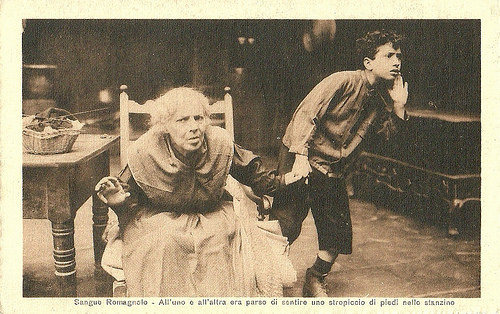
Italian postcard. Caption: Both thought they heard a scruffing of feet in the closet.
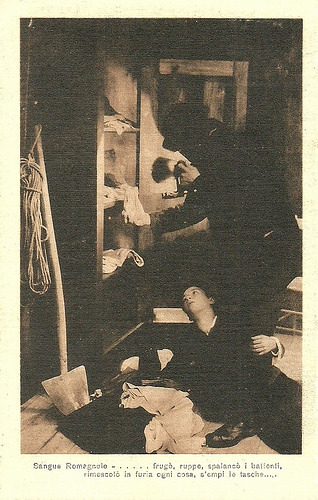
Italian postcard.Caption: He searched, smashed, threw open the drawers, messed anything in fury, and filled his pockets.
A little mystery
The Italian production company Film Artistica Gloria adapted in 1916 some stories from Edmondo De Amicis' popular book Cuore about the life of nine boys in a school class in the city of Turin. Earlier, we did a post on Dagli Appennini alle Ande/From the Apennines to the Andes (Umberto Paradisi, 1916).
The book Cuore had been a great success because the characters of the stories were from various parts of Italy, giving a strong hint to the unity between the various regions of the Kingdom, both culturally as well as politically.
In the short silent film Sangue romagnolo/Blood from the Romagna (Leopoldo Carlucci, 1916), Luigi Petrungaro plays Ferruccio, a boy from the Italian Romagna Region.
One night young Ferruccio is mischievous but not really bad. Wrong companions extort money from him. He returns home late while his parents are away.
Only his grandmother is at home who accuses him of 'killing her' with his bad friends. Suddenly they hear noise and discover two burglars. While one grabs the old woman by the throat, the other makes Ferruccio tell where the money is hidden.
When leaving, one bandit loses his mask and the others recognize him as one of Ferruccio's mates. He wants to knive the woman but Ferruccio throws himself before him and receives the fatal knive wound.
The Cineteca Italiana has preserved Sangue romagnolo (1916) and you can view the whole film at their website. Strangely enough it seems a totally diferent film: different setting, different actors. Were two versions made by Film Artistica Gloria? The postcards are definitively made for the Gloria production. Who can solve this little mystery?
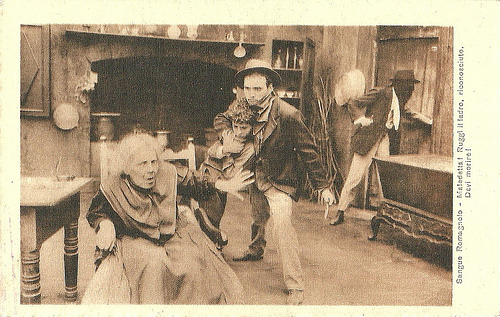
Italian postcard. Caption: Damned woman, the thief shouted when recognized, you will die!
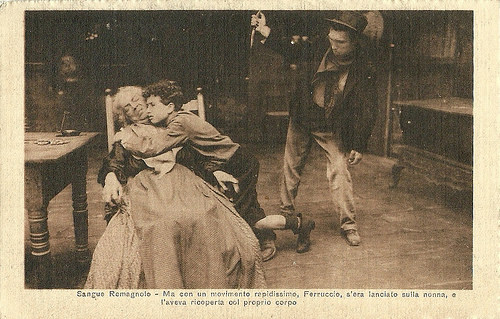
Italian postcard. Caption: With a most rapid move, Ferruccio threw himself in front of his grandmother and covered her with his body.
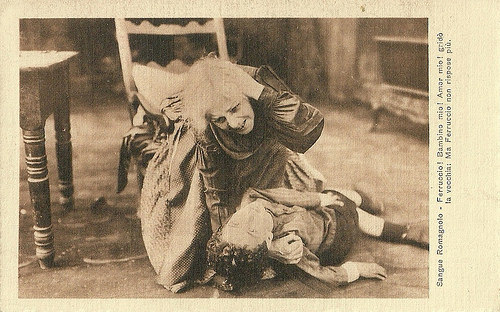
Italian postcard. Caption: Ferruccio! My child, my love! the old woman cried. But Ferruccio didn't answer anymore.
In 1984, director Luigi Comencini remade Sangue romagnolo as an early silent film for his series Cuore/Heart for the RAI television. Source: Doncamillof (YouTube).
Sources: Fondazione Cineteca Italiana, Wikipedia (Italian) and IMDb.

Italian postcard. Caption: Both thought they heard a scruffing of feet in the closet.

Italian postcard.Caption: He searched, smashed, threw open the drawers, messed anything in fury, and filled his pockets.
A little mystery
The Italian production company Film Artistica Gloria adapted in 1916 some stories from Edmondo De Amicis' popular book Cuore about the life of nine boys in a school class in the city of Turin. Earlier, we did a post on Dagli Appennini alle Ande/From the Apennines to the Andes (Umberto Paradisi, 1916).
The book Cuore had been a great success because the characters of the stories were from various parts of Italy, giving a strong hint to the unity between the various regions of the Kingdom, both culturally as well as politically.
In the short silent film Sangue romagnolo/Blood from the Romagna (Leopoldo Carlucci, 1916), Luigi Petrungaro plays Ferruccio, a boy from the Italian Romagna Region.
One night young Ferruccio is mischievous but not really bad. Wrong companions extort money from him. He returns home late while his parents are away.
Only his grandmother is at home who accuses him of 'killing her' with his bad friends. Suddenly they hear noise and discover two burglars. While one grabs the old woman by the throat, the other makes Ferruccio tell where the money is hidden.
When leaving, one bandit loses his mask and the others recognize him as one of Ferruccio's mates. He wants to knive the woman but Ferruccio throws himself before him and receives the fatal knive wound.
The Cineteca Italiana has preserved Sangue romagnolo (1916) and you can view the whole film at their website. Strangely enough it seems a totally diferent film: different setting, different actors. Were two versions made by Film Artistica Gloria? The postcards are definitively made for the Gloria production. Who can solve this little mystery?

Italian postcard. Caption: Damned woman, the thief shouted when recognized, you will die!

Italian postcard. Caption: With a most rapid move, Ferruccio threw himself in front of his grandmother and covered her with his body.

Italian postcard. Caption: Ferruccio! My child, my love! the old woman cried. But Ferruccio didn't answer anymore.
In 1984, director Luigi Comencini remade Sangue romagnolo as an early silent film for his series Cuore/Heart for the RAI television. Source: Doncamillof (YouTube).
Sources: Fondazione Cineteca Italiana, Wikipedia (Italian) and IMDb.
Published on August 28, 2015 22:00
Paul van Yperen's Blog
- Paul van Yperen's profile
- 13 followers
Paul van Yperen isn't a Goodreads Author
(yet),
but they
do have a blog,
so here are some recent posts imported from
their feed.



